












By Erin Wu (‘25)
When Mr. Barrus, my Film Production teacher, first announced that a trip to Palau was in the works for students to create a documentary on the nation’s coral reef conservation, I admit: I was skeptical. It was hard to believe that within the next two months, all the logistics and moving parts would come together to allow his grandiose vision to come to fruition. As the date of departure loomed closer, however, the expectation I had of it all to be called off began to wane. We pushed full steam ahead, taking on training after training in preparation for the trip. Finally, the long-awaited date was here: as I boarded the plane giddy with anticipation, my mind swelled with images of white sand beaches, sunset walks along the coast and crystal blue waters stretching for miles beyond the horizon. However, this was far from the reality we would experience. roughout the next five days, I would suffer from sleep deprivation, be confronted with some of my biggest fears and end each day in a sweaty, sticky-from-sunscreen state; my body and energy was pushed to their utmost limit on the daily. Despite the hardships, I wouldn’t have changed an aspect of the trip. ose five days were among the most impactful few of my life. A cliche perspective, maybe: feeling fundamentally changed after a single trip. Beyond the knowledge I learned about coral conservation from the various experts we interviewed, I learned more major life skills in those five days than I ever have from classes or school. From the heat stroke I got on the first hike we did, trekking on a stone path through the dense forest, I learned just how important it is to stay hydrated. From the harsh tan lines I discovered at the end of each day, I learned how much more often I should be reapplying sunscreen. And finally, from the many hours we spent snorkeling in the water, I saw firsthand how delicate marine life truly was. en there was the social aspect. So picture this: when 18 students, practically strangers to one another, are brought to a completely unfamiliar island to spend the next five days together, what could the outcome possibly be? Before going on the trip I fully expected to keep to myself, interacting with others only when necessary. However, contrary to what I thought, by the end of the trip, we were all closer than any of us could have anticipated. Enduring hardships together, sharing rooms and playing nightly card games were only a few of the ways we grew to become friends.
We were all there for one purpose: to learn and explore. All being from different departments, each time we helped out one another, the more we understood about each area: from music to film, to science.
Although my initial impressions were slightly off, many were still met, albeit in a different way. ere wasn’t any lounging and strolls on beaches, but we did swim alongside all sorts of marine life in the most pristine waters and experience an environment brimming with culture. Every time I see any one of the members that attended, we share a secret: the magic of Palau.


By Eric Fang (‘28)
In the weeks following his dreaded return to o!ce on Jan. 20, 2025, United States (US) President Donald Trump has been quick to declare a urry of executive orders and policies that uphold his “America First” agenda, receiving both support and controversy. From immigration crackdowns and trade tari s, his actions have set the tone for a presidency that could rede$ne the nation’s policies and in uence stability on the global stage for decades to come.
One of Trump’s most notable moves was the declaration of a national emergency at the United States-Mexico border, authorizing the secretary of defense to reallocate funds within the department to subsidize construction of the border wall. Included in his series of proclamations was the proposal to terminate birthright citizenship for children of undocumented immigrants. Legal experts have raised concerns, citing con icts with Section
1 of the 14th Amendment, which grants American citizenship to all persons “born or naturalized in the United States.”
On the economic front, Trump plans to impose an additional 25% increase in tari s on Canadian and Mexican imports, while imposing 10% on goods from China. %e administration explains this as a plan for the US to be self-reliant on manufacturing, but critics argue it could strain trade relations and drive up consumer costs. %e Tax Foundation, a nonpartisan tax policy organization, estimates the tari s on China alone would add USD$172 to the tax burden of the average US household and a ect more than USD$450 billion worth of imports.
President Trump also moved to shut down all Diversity, Equity and Inclusion (DEI) o!ces in the federal workforce.
Similar to the ban on a!rmative action, this aims to combat “unlawful or reverse discrimination,” portrayed by the o!cial White House website as “the most
important federal civil rights measure in decades.” %is, coupled with the mandate recognizing only two genders under federal law, has sparked debate across the nation between liberals and conservatives.
“What Trump is trying to do is to make sure, no matter what you’re trying to identify as, you’re gonna be protected under the US Constitution and not just some paper politics, like what Biden is doing,” said Raymond H. (‘27), a supporter of the current president.
Aside from enacting his own policies, Trump has also announced the withdrawal from key intergovernmental organizations such as the United Nations Human Rights Council (UNHRC) and the World Health Organization (WHO). While this may strengthen US control over domestic health and foreign aid spending, it marks a step back from its moral obligation to support vulnerable communities in underdeveloped nations and regions in dire need of humanitarian aid.

By Ray Lee
On Jan. 18, 170 million Americans were left in despair as the popular social media app, TikTok, was banned in the United States (US).
Two days before the o!cial ban, TikTok had attempted to appeal the ban in the Supreme Court, but their appeal was unsuccessful as the Court ruled against them. Congress $rst decided to pass the law that would ban TikTok due to concerns about TikTok’s parent company, ByteDance, and its relations with the Chinese government. Congress was worried about the security of TikTok users in the US, as they suspected that the Chinese government had access to users’ data. %e law that was passed o ered TikTok two endings: to either get banned in the US, or to sell a part of TikTok to a US-certi$ed buyer.
Concerns about TikTok’s security
originated in 2020, when President Donald Trump requested for the shutdown of the app. On Aug. 6, 2020, Trump signed an executive order that pressured TikTok into selling to a US buyer. His attempts were ultimately unsuccessful, and TikTok continued to thrive in America for the following $ve years.
Four years after Trump’s initial attempt, during April of 2024, the House of Representatives brought the issue back, and passed the Protecting Americans from Foreign Adversary Controlled Applications Act. Once again, the concern remained the same with the issue of TikTok being a national security risk. %e act essentially required ByteDance to sell TikTok to a US-approved buyer in order to continue the app’s operation in the US. After the act was passed, TikTok and ByteDance then decided to sue the US government, claiming that the act was unconstitutional as it
attempted to restrict freedom of speech, a right enumerated in the First Amendment. %e dispute made its way to the Supreme Court, where the Court unanimously ruled against TikTok, rejecting its claim that the law limited First Amendment rights.
%e day after the Court rejected TikTok’s claim, TikTok was o!cially banned as the app stopped working across the US. When users opened up the app, they were met with an unfortunate message stating,
“A law banning TikTok has been enacted in the U.S. Unfortunately, that means you can’t use TikTok for now.”
170 TikTok million users were devastated as the app was shut down, but especially in uencers and business-owners who were dependent on the platform for their work. %e ban left many users appalled, with some arguing that the ban was unreasonable as there was no concrete
evidence of security risks.
“It’s hard to see evidence directly of what [the US government is] claiming,” said Mr. Farley, an Upper School history teacher and regular user of TikTok.
However, just 12 hours after the ban was initiated, users were greeted with a message on TikTok that read:
“%anks for your patience and support.
As a result of President Trump’s e orts, TikTok is back in the US!”
President Trump had signed an executive order that granted TikTok another 75-day extension to either sell or ban the platform. Many TikTok users have commented about Trump’s sudden change of heart, and have suspected that his motive is to come out on top as the ‘hero’ who saved the platform.
“It’s a way of getting popular support,” said Mr. Farley. %e 75-day extension is still currently active as Americans continue to wait for TikTok’s decision.

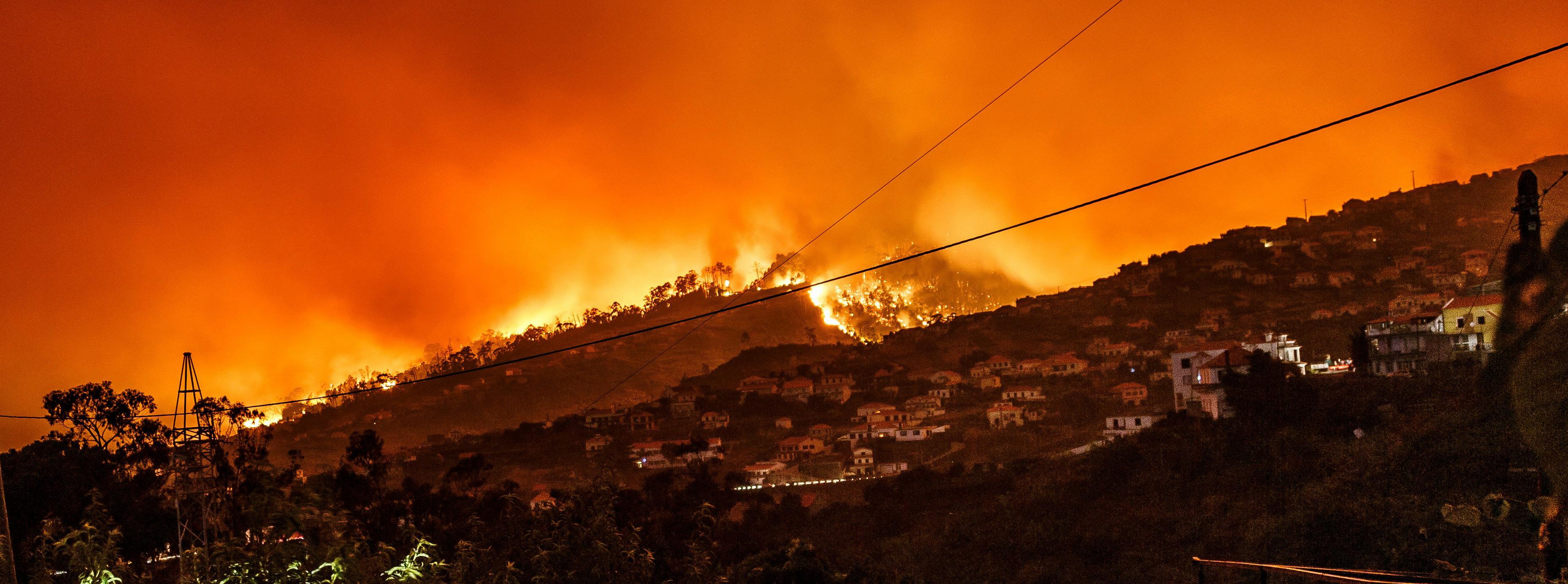
By Minsun Kim
On Jan. 7, 2025, Los Angeles (LA) experienced one of the worst wild res in decades. Four res burned across the state, causing 29 deaths.
Nearly 20,000 people were a ected, having to evacuate from their homes and many being left homeless.
While the original cause of the devastating res has not yet been determined, scientists have con rmed that the hot, dry conditions caused by climate change have signi cantly worsened the extent of the damage the wild res have caused. e strong Santa Ana winds have also intensi ed conditions by stripping the vegetation of moisture, allowing res to catch and spread easily.
While the res raged in California, they
also a ected the Taipei American School (TAS) community in Taiwan.
Many members of the TAS student body and faculty have been struck. Numerous students and teachers have family residing in Los Angeles and the nearby area, creating a sense of worry and concern among them. Many others also consider California their home and often return for vacations.
Reina C. (’28) and Austin B. (’28) have shared similar experiences regarding the wild res, both having families, friends and properties in LA.
Austin shared his aunt’s experience with the res, stating that her commute to work had been greatly disrupted, making the journey signi cantly longer, as the roads
were blocked.
“[During the res], the skies in Pasadena have turned really red and it [was] a constant presence around the area,” said Austin. Moreover, Reina also commented how her family’s property in LA was close to being ruined and expressed her concern for future res. is could have an economic impact all throughout the world,” she said. ey both agreed that the local authorities did the best they could do to stop the res and support those a ected, but also emphasized how the re department in California could have been more prepared.
Ms. Hsiao, a member of the math department at TAS, also voiced her story
and how her family and friends have been a ected.
With her family living near Pasadena, she rst found out about the wild res from her sister.
She mentioned that her family lives close to the Eaton re.
“ e air quality was really bad, and we did move things out of the house, just like important documents,” she said.
Furthermore, she stated that while she is concerned about future wild res in the area, it is a common occurrence, and people have become used to them over time. With climate change worsening these wild res, the TAS community must stay prepared and alert in the future.

Students compete in the competition.
By Karson Ko (‘28)
is year, Taipei American School (TAS) dominated the American School in Japan (ASIJ) VEX competition. ree out of the four teams that competed were able to make it into the nals, which allowed TAS to win the nals and go on win the Design Award, Excellence Award and the Finalist Awards.
VEX is a robotics competition that is popular among TAS students. For this year’s theme, High Stakes, there were three ways to score points with rings. e rst way to score points is to make the robots put the ring onto a green shaft vertically on a hexagon platform that tips and moves when pushed called the mogo or “mobile goal.”
Another way to score points is to put rings into a taller shaft that is connected to
the wall. Robots need to be able to extend what is called an “arm” on the robot and reach the top of the shaft to put it in.
Along with putting rings on the “alliance stake,” which is colored blue or red and is similar in height with the mogo, but connected to the wall.
During the game there are ve mogos. ere are 22 blue rings and 22 red rings. Two paired teams compete against another two paired teams. During the match, there are four corners that can bene t you or can give you a disadvantage during the game, the negative corner and positive corner. If the mogo is dragged and put into the negative corner, the rings cause the teams to lose points. If it is dragged to the positive corner,
the rings double points. e blue team needs to get as many points as possible by putting blue rings onto the mogo, wall stake and alliance stake and the same goes for the red team.
e winner of the game is the pair that scores the most points. Students build these robots from scratch using creativity and their imagination to create new techniques and mechanics that can give the robot an advantage.
Team 4253R, with Eric L. (’25) as the captain, won the tournament as well as winning the Finalist Award and Design Award. Teams 4253S and 4253U also made it to the nals with Remiel L. (’26) and Brendon L. (’26) as their respective captains,
helping 4253S win the Excellence Award.
During the quali cations, 4253U ranked rst place overall, 4253S ranked sixth place and 4253R were ranked second. e rankings are important as they set up the order in which a team picks their alliance. When interviewing Brendon about strategies used during the event, he simply said “to win.”
During discussions of choosing who to ally with 4253U chose 4253S. While 4253R teamed up with a Japanese school team “Tina Robotics”. 4253S and 4253U made it to the nals along with 4253R and Tina robotics. e nals were a best out of three matches and in the end 4253R and Tina Robotics won.

800 CHUNG SHAN N. RD. TAIPEI 11152 TAIWAN
EDITOR-IN-CHIEF ERIN WU (‘25)
MANAGING EDITOR (PRINT)
ANNABELLE HSU (‘27)
MANAGING EDITOR (ARTICLES)
SOFIA VALADAO (‘26)
STAFF WRITERS
AMBER HU (‘27)
SIAN PARK (‘27)
HANNAH WANG (‘27) MATTHEW WANG (‘27)
DENNIS (‘28)
FANG (‘28)
HO (‘28)
MINSUN KIM (‘28)
KARSON KO (‘28)
COLIN KUO (‘28) RAY LEE (‘28)
ANGELO LIEN (‘28)
AUSTIN WANG (‘28)
BRYCE YAO (‘28)
ADVISER
MR. PATRICK YOUNG
MISSION STATEMENT
The Blue & Gold is a student-run publication dedicated to sharing stories from the Taipei American School community. Produced and distributed free of charge monthly during the academic year by sta writers at TAS, the Blue & Gold strives to showcase and interrogate the community it serves.
CORRECTIONS
We take all measures possible to report accurately, and seek to bring professional, thorough reporting to our readers. Please report any inaccuracies in Blue & Gold content to blueandgold@tas.tw.
OP-EDS AND EDITORIALS
Editorials collectively represent the opinions of the Blue & Gold’s editorial board, while op-eds represent the opinions of each writer. Opinions in the Blue & Gold do not necessarily re ect the views of TAS student body, sta , faculty, or administration.
THE BLUE & GOLD ONLINE
The Blue & Gold runs an online edition that publishes articles every weekday when school is in operation. Find the website at blueandgoldonline.org.
LETTERS TO THE EDITOR
We welcome letter submissions from all readers. Email your signed letter of under 500 words at blueandgold@tas.tw.

By Chester Dennis (‘28)
Tattoos: they were once considered taboo in most professional settings, but they have now become common forms of self-expression and storytelling. Many teachers here at Taipei American School (TAS) wear their ink proudly, each piece carrying a personal story. Today, we explore the meanings behind the tattoos of three TAS teachers, Ms. Ing, Mr. Mitchell and Mr. Pattenden, while also learning more about the culture of tattoos.
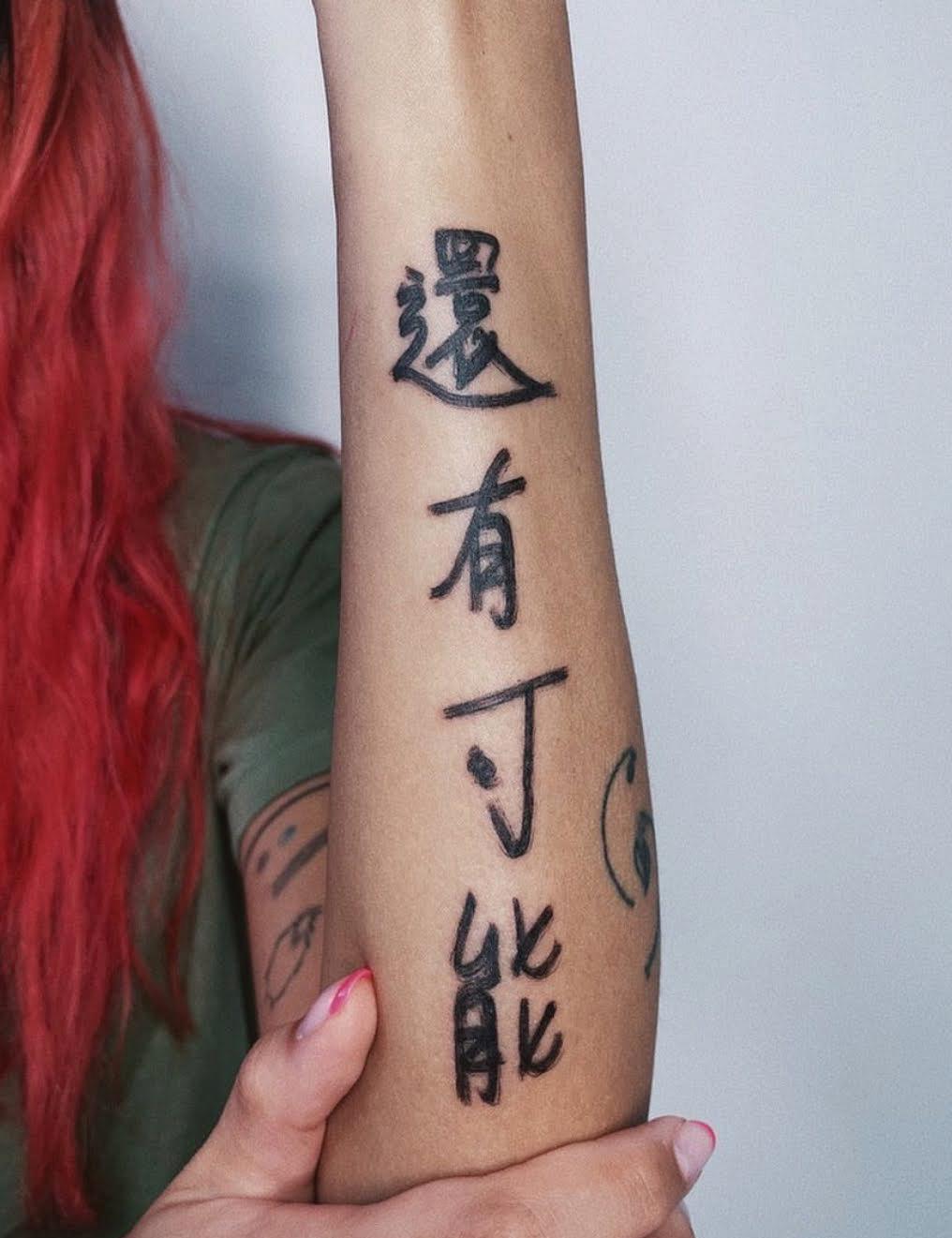
For dance teacher Ms. Ing, tattoos are about relationships and shared experiences.
“My first tattoo was a friendship tattoo, as are several of my others,” she said. “Most of them aren’t deeply symbolic—I got them as celebrations of friendship.”
While some of her smaller tattoos serve as keepsakes from specific times and places, her larger pieces carry more significance.
“Since most of my bigger tattoos were done by two of my closest friends, they also represent trust,” said Ms. Ing, “getting my first tattoo was an easy decision because it was with someone I care about deeply.”
Over the years, she has received more compliments than criticism about her tattoos. “People of all backgrounds and beliefs have reacted positively,” she said. “If anything, my tattoos have made me feel more confident in myself.”
For those considering their first tattoo, Ms. Ing o ff ers a word of caution: “Be smart. Do your research—not just on the design, but on the artist. Look into their style, their previous work and even the communities they’re part of.” Ultimately, the person who is receiving the tattoo is you, not somebody else.
Mr. Mitchell, a Physical Education (PE) teacher with an eye for traditional Japanese and Americana tattoo styles, recalls his first tattoo at age 20.
“I was living in Virginia at the time, playing football and hanging out with people who owned tattoo studios,” he said, “I got my first tattoos because I wanted to look good on the field.”
His most recent piece was done by a friend learning hand-poked tattooing.
“He needed practice, so I let him work on me,” he said.
For Mr. Mitchell, some tattoos hold sentimental value.
“[I’ve] had five dogs—Luna, Butters and Ruby were my first as an adult,” he
explained, “two of them passed away, so I got tattoos of them to keep their memory alive.”
Despite the increasing acceptance of tattoos in professional spaces, Mr. Mitchell acknowledges that workplace perceptions still vary.
“My advice? Make sure you get something you’re willing to live with forever,” he said, “and consider placement. Some jobs still judge visible tattoos, so it’s good to have the option to cover them.”
As for his tattoo plans, he’s not finished yet. “My whole back is still open,” he said with a laugh, “but I’m running out of space on my torso.”

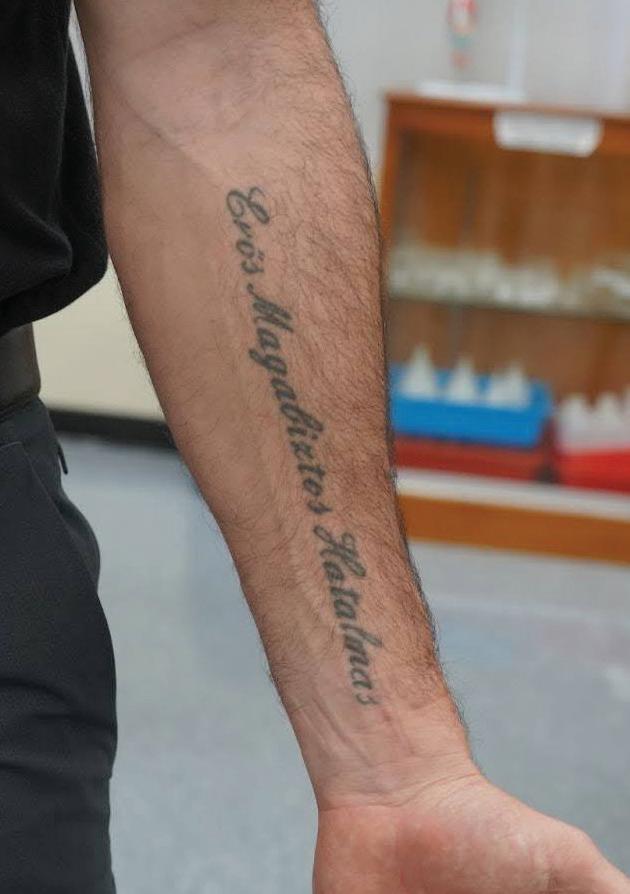
For middle school science teacher
Mr. Pattenden, getting a tattoo was a long awaited desire. “I wanted something personal to me. at’s the problem with tattoos—people get things they have no real connection to,” he said.
With a Hungarian background stemming from his mother’s side, and years of training and dedication to become a professional football player, he found meaning in an a ffi rmation he repeated in moments of self-doubt: “I am strong, confident, & powerful.”
“Whenever I felt unconfident, I would say those three words to myself,” he explained.
e saying became his inspiration for his tattoo, inked in Hungarian as Eros, Magabiztos, Hatalmas, a permanent reminder of how resilient he can be.
e way he acquired the tattoo was extraordinary though: “I worked as a radio announcer, and for my 30th birthday, my co-host said, ‘I have a present for you.’ I had talked about getting a tattoo a lot,” so I ended up getting it drawn on my forearm live on the radio.”
Now, his tattoo often sparks conversations. “People who speak multiple languages come up to me because of it,” he said, “Hungarians recognize it too—it’s a unique language.”a
For those considering a tattoo, he o ff ers simple advice: “Find something meaningful to you, and be absolutely sure that you want it.”
As for future ink? “I have one on my left side, and I’m a symmetrical person,” he said, “I’m thinking about a compass on my right calf muscle.”

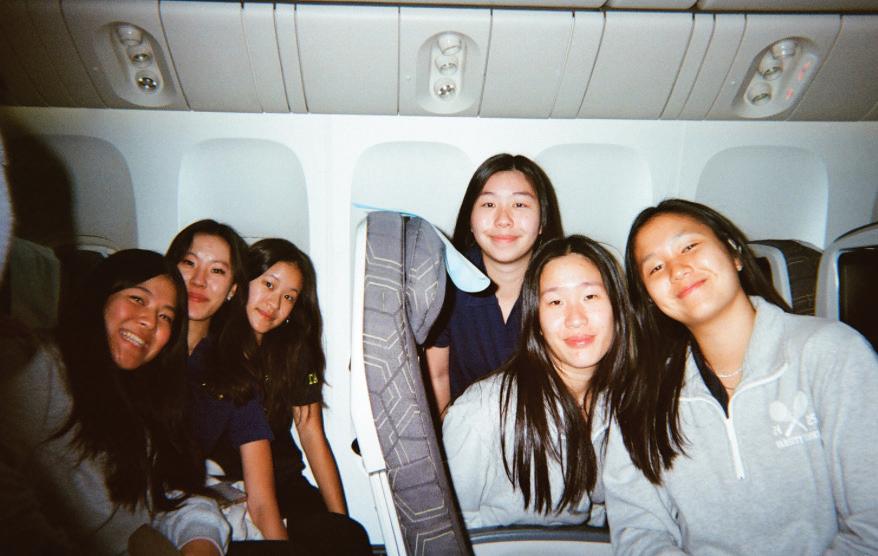

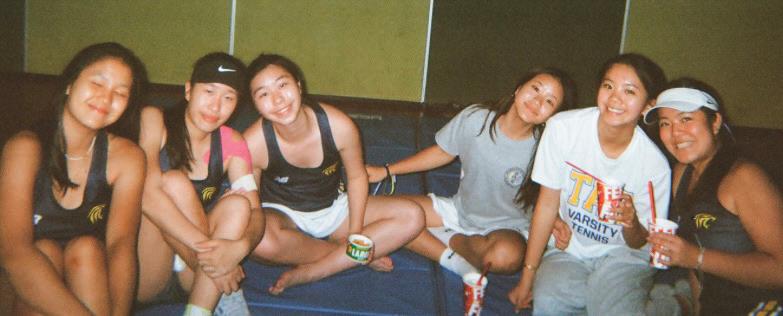

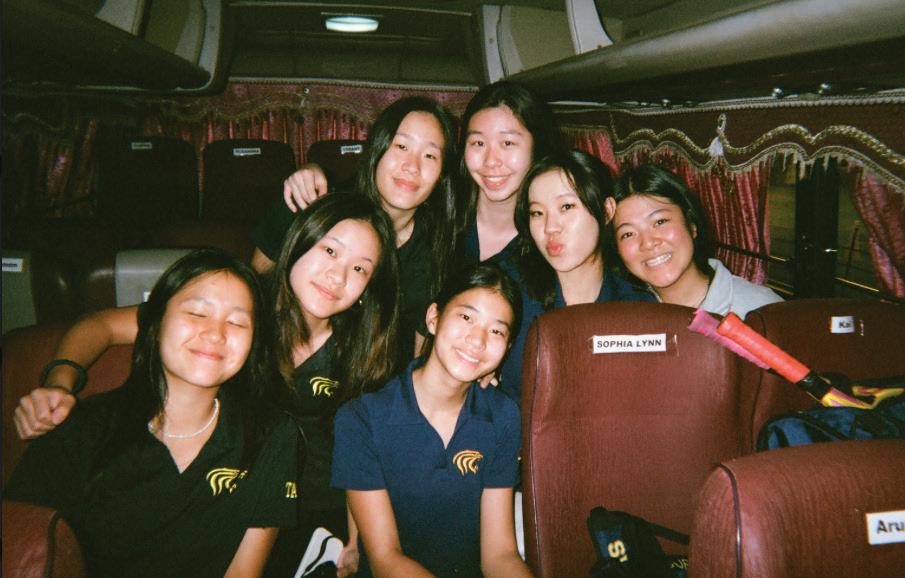
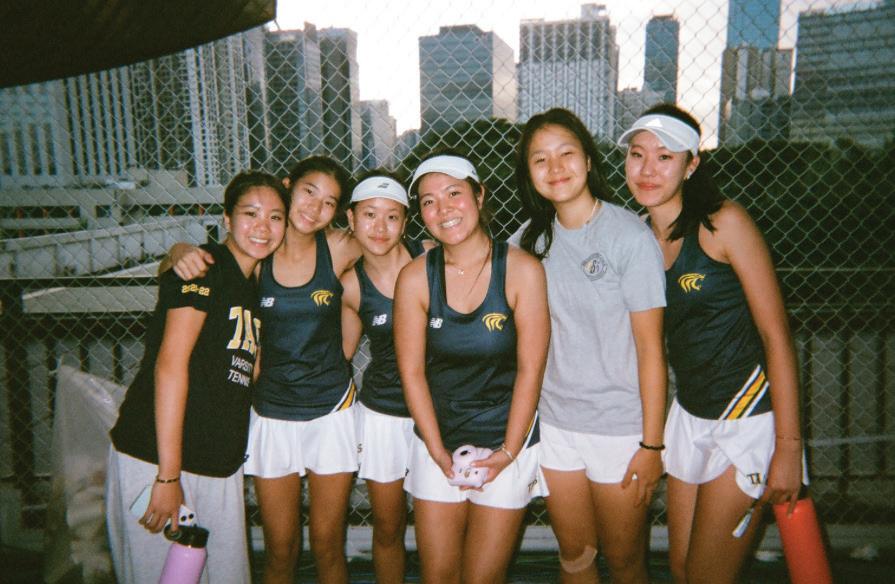
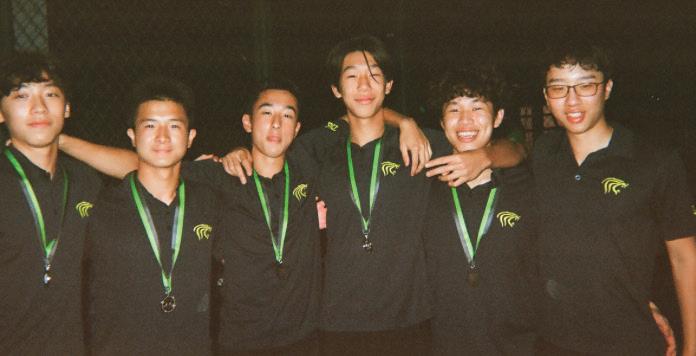

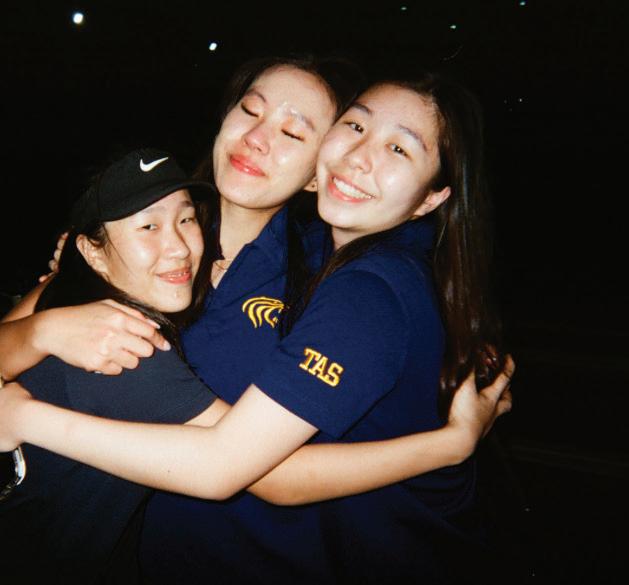





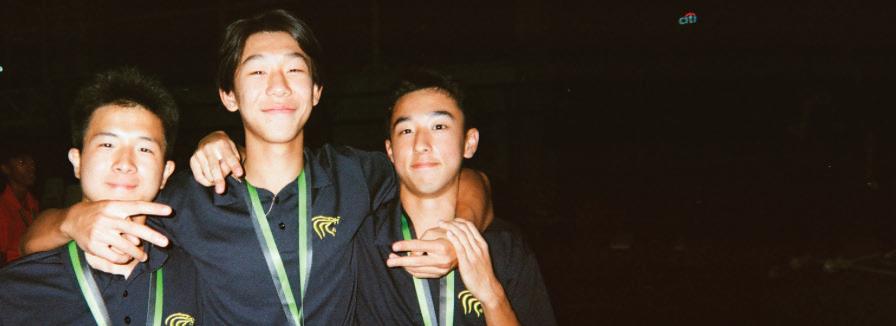


e TAS girl’s swim team at IASAS finished in second place like the boys.
TAS obtained several individual medals over the two days of competition. Since this was the first time that TAS has hosted swimming IASAS for over a decade, the environment was very different for the athletes due to TAS being the only school having an indoor swimming pool. One of the biggest challenges of IASAS was most notably the fact that it was after winter break.
Due to this, “we were incredibly out of shape and rusty after the break” Ina C. (‘25).
However, the girl’s team quickly trained for IASAS and some even achieved personal bests.
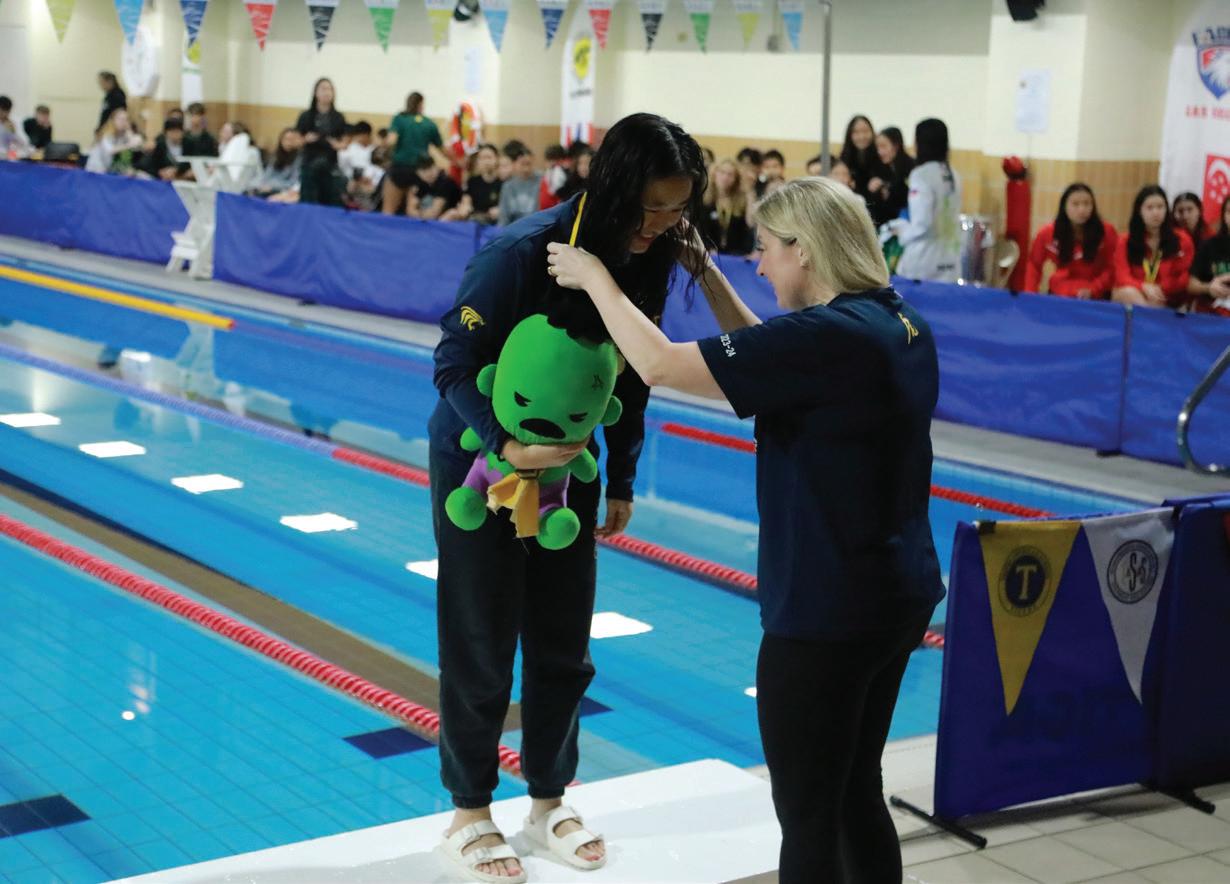
is year, International Association of Southeast Asian Schools (IASAS) swimming was hosted at Taipei American School (TAS), with the TAS boy’s team earning a silver medal. e boys showcased outstanding performances across multiple events, with swimmers breaking personal records. is year’s swimming was especially significant due to TAS not hosting IASAS swimming for over a decade.
“I couldn’t be prouder of my team and I want to thank each of them for making this final IASAS so memorable,” said the captain of the swim team, Will B. (‘25).


e TAS girl’s touch team earned a bronze medal at Bangkok.
After a rough first day at IASAS, the girl’s rugby team made a miraculous comeback on the second day, which was a defining moment for the team. Beyond the competition, IASAS gave the girls a lot of great memories.
“Hugging Aleesa after our last match, both of us in tears, was a moment I’ll never forget—we were exhausted and heartbroken that our time with TAS Touch was over,” said Addison T. (‘25).
“[We were] more than just teammates, IASAS was a place of bonding, as we went to Bangkok as a team and came back as a family,” she said.
At the International School of Bangkok (ISB), the TAS boy’s rugby placed fifth, marking the end of a challenging yet rewarding season.
Despite the placement, the players cherished the IASAS experience, highlighting the tournament as a great opportunity to meet new people.
Reflecting on the season, one of the main challenges of the Rugby season was that “some players didn’t like the pressure,” said Daley T (‘28), a rugby player.
Every game matters at IASAS, and the team’s ability to support one another under intense pressure is what brought the boys closer together.
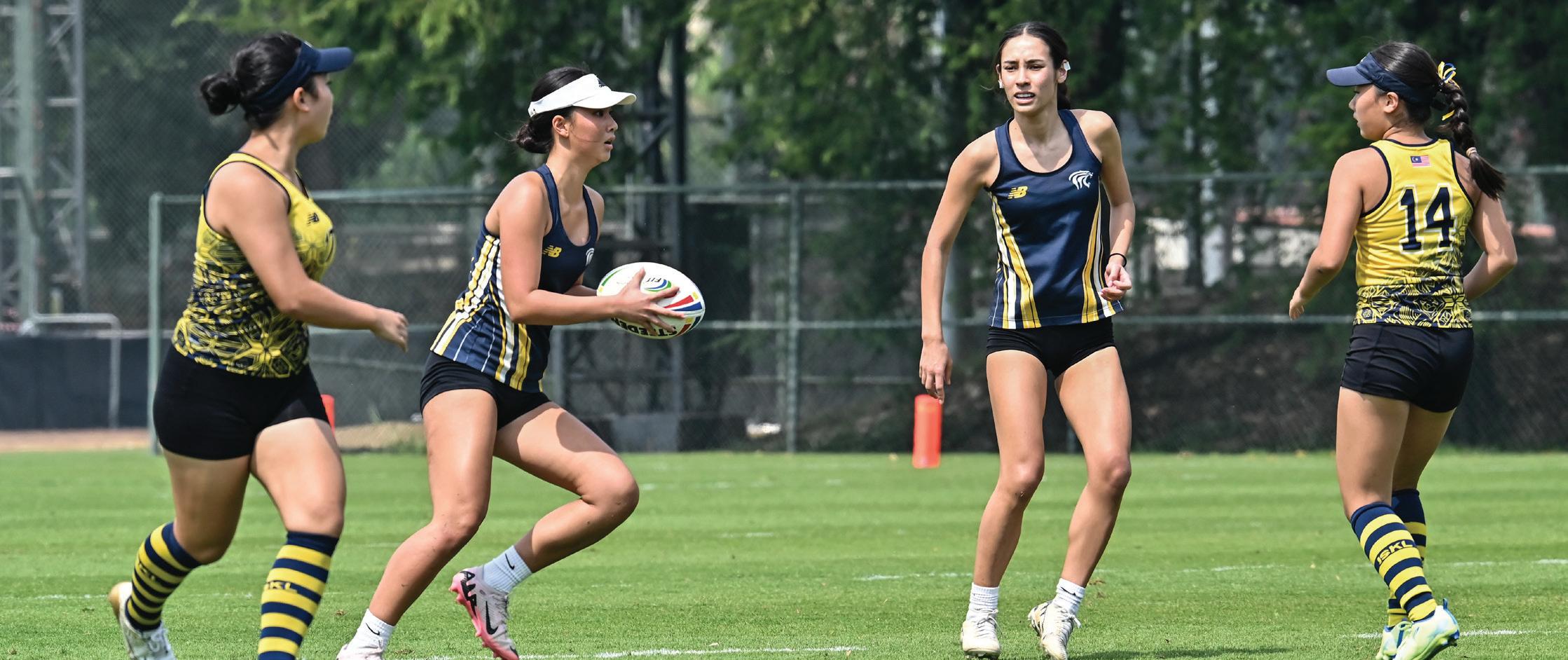


!e TAS girl’s team put in a strong effort at IASAS and placed fourth. One of the main challenges was how much the other teams improved, but despite the setbacks, the girl’s tennis team demonstrated resilience and fought very hard.
Beyond the competition, playing at the ISB was a unique experience, as team captain, Lorraine W. (‘25) noted that “it was very fun to play on grass courts.”
Overall, one of the best things about the journey for IASAS for girls’ tennis is the friendships they made along the way, especially with the ISB team. !e girls returned to Taiwan proud knowing that they played their best performance of the season.
!e TAS boy’s tennis team secured a silver medal in the International School of Manila (ISM). !e tennis team went in as defending champions and carried high expectations, showcasing their skill and determination throughout the competition. Despite losing in the finals, the team had an outstanding performance. Beyond their on-court achievements, the team formed an unbreakable bond throughout their IASAS tennis journey. “We were family and I enjoyed every moment I spent with them and I want to thank my teammates for making my high
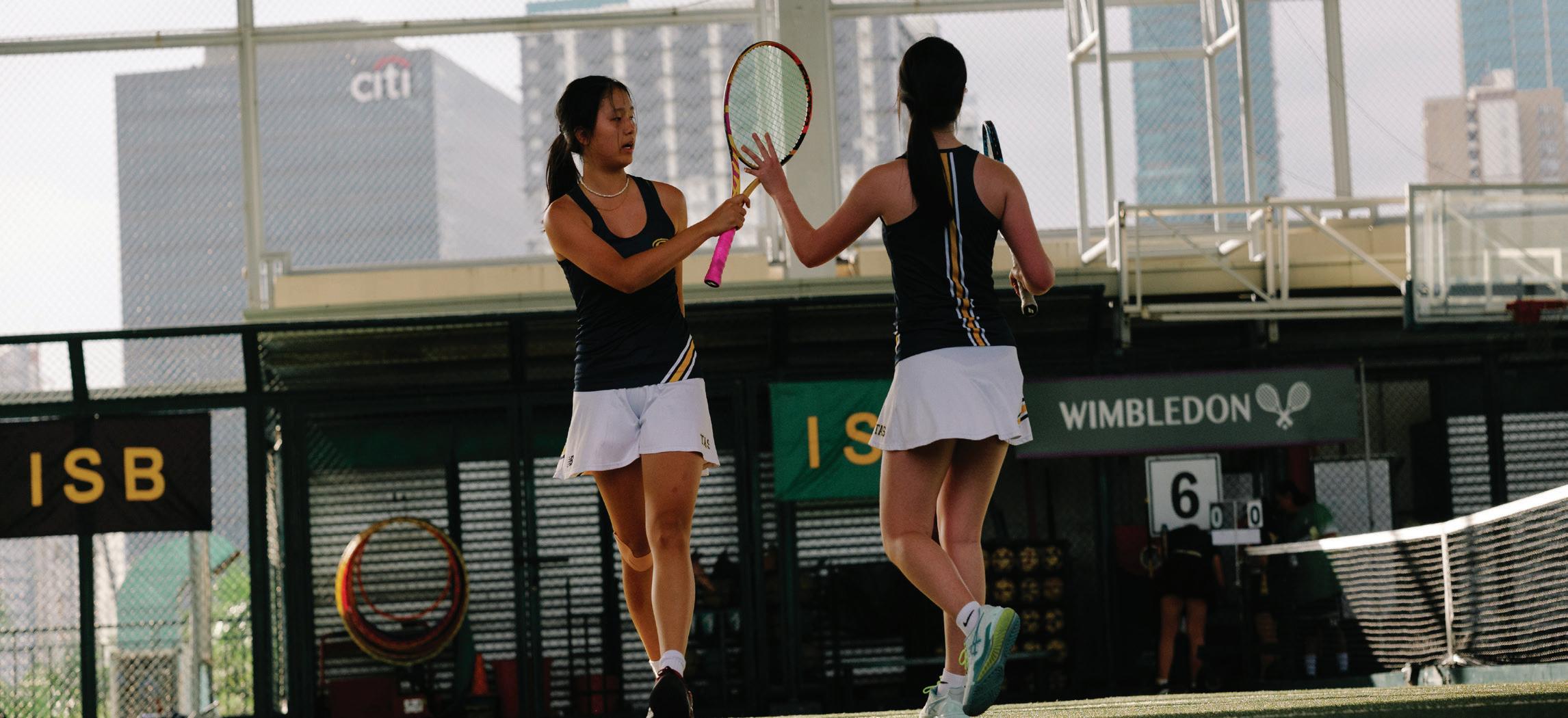

!e TAS girl’s basketball team had a fantastic performance, holding onto their gold medal in IASAS.
!e atmosphere at the finals was surreal, and a lot of IASAS schools were rooting for TAS.
“Looking at the crowd from the bench is insane, imagine about 100-plus people watching you play,” said freshman athlete, Catherine C. (‘28).
!e season, however, was not without its challenges. Despite the challenges presented, the team ultimately supported and encouraged one another.
!e team hopes to continue their gold streak for the next years to come.

! e TAS boy’s basketball team placed fifth at the International School of Kuala Lumpur (ISKL), finishing the season with perseverance and teamwork.
While the competition was tough, the team remained determined and gave their all in every game.
Despite the results of IASAS, the boys made lots of friends along the way and the IASAS experience was unforgettable.
! e boys left Kuala Lumpur with their heads held high and ready to come back even stronger next year.
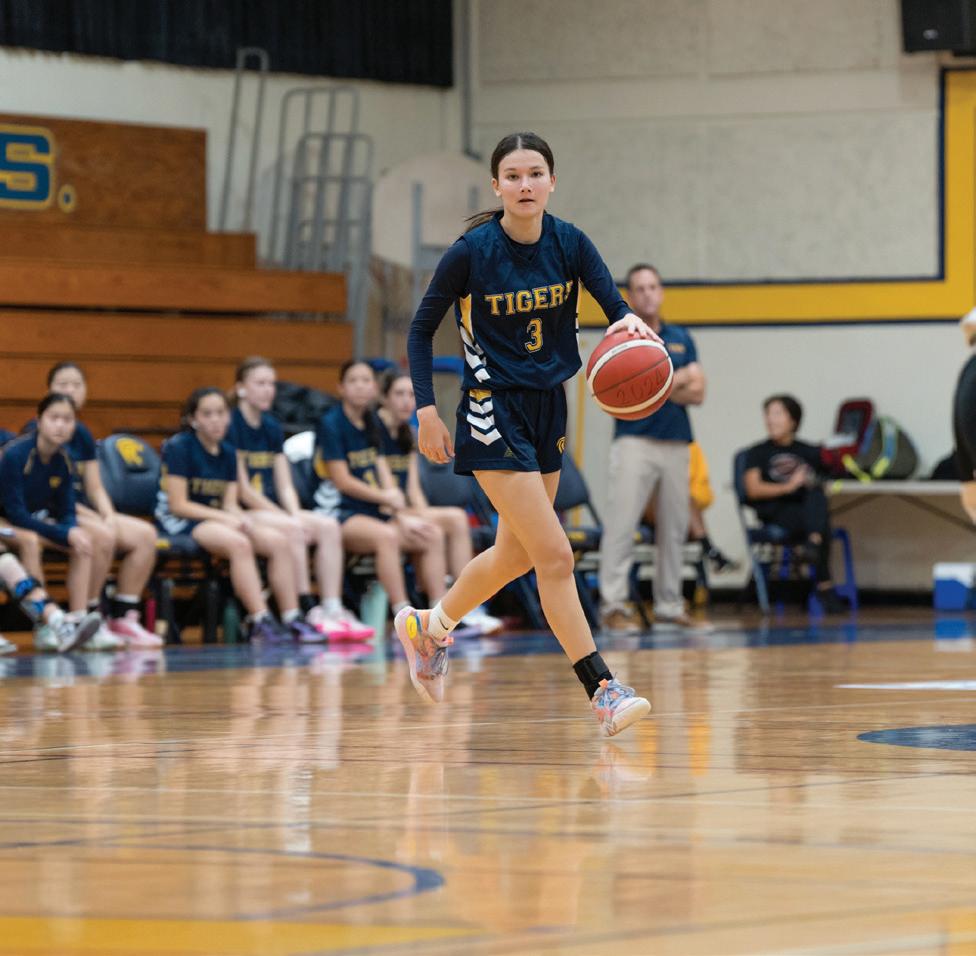

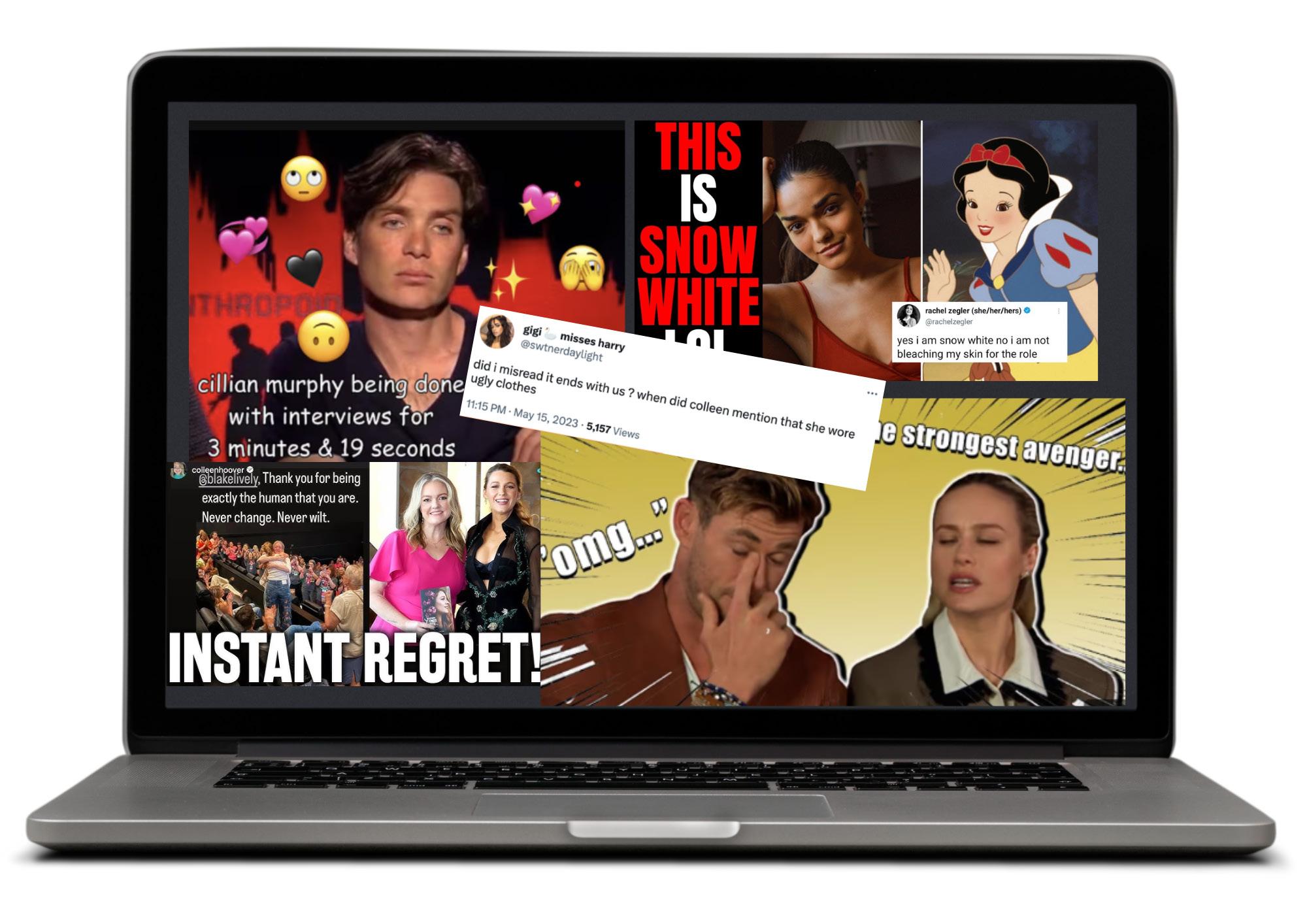
By Davina Jou (‘25)
e internet likes to think of itself as feminist. Or, at the very least, it’s not nearly as bad as what came before—the tabloids and Perez Hiltons of the world, who bullied and humiliated female celebrities during their darkest moments. We’ve told ourselves that we’re past that, we’re better than that…and what happened to Judy Garland and Marilyn Monroe and Britney Spears and Lindsay Lohan will never happen again.
While modern-day discourse may be less explicitly misogynistic, the intense bullying towards female celebrities hasn’t stopped. e recent controversy surrounding actors Blake Lively and Justin Baldoni is a key example. For weeks, social media was ooded with criticisms against Lively for her problematic behaviour during press interviews, while her co-star in the 2024 lm “It Ends with Us,” Justin Baldoni, was praised as a “true feminist.” Her case isn’t unique: before her, there was Rachel Zegler; and before her there was Brie Larson; the
list goes on. ese controversies are part of a longstanding pattern of harassment and gender double standards directed towards female celebrities.
Often, the harassment is dressed in a morally righteous skin. Taking a look at recent articles and videos made about Lively, the hate is justi ed with headlines proclaiming “Blake Lively’s mean girl image exposed” and “Blake Lively branded a ‘nightmare to work with’ by a-list star” (Daily Mail). She’s a ‘diva’, a ‘mean girl’, ‘unprofessional’. Accusations that supposedly would be lobbied at her even if she was a man. Except that’s not entirely true.
Let’s talk about one of the major criticisms lobbied against Lively – her unprofessional conduct during interviews. is critique is also not unique to her – stars like Brie Larson and Rachel Zegler have been similarly criticised for their ‘entitlement’ and focusing heavily on their movies’ feminist
themes in press interviews, in “Captain Marvel” and “Snow White” respectively. Yet doing so ignores how publicity works. Lively was hated for supposedly ignoring the lm’s focus on domestic violence, but it was revealed in a New York Times expose that the o$cial promotional plan speci cally instructed the cast to “embrace a oral theme” and decenter the distressing aspects of the story. Chances are, Zegler and Larson were similarly in uenced by their marketing teams to focus on aspects of their movies, that unfortunately were found annoying by the general populace.
And in terms of Lively’s supposed rudeness well, let’s be honest: so what? Who cares about a few rude remarks? We certainly didn’t when Robert Downey Jr. walked out on Channel 4 interviewer Krishnan GuruMurthy after being asked about his past struggles of addiction and arrest, despite his previous scandals being a huge part of his appeal. e scenario was remarkably similar to Lively’s 2016 interview with Kjersti Flaa that resurfaced during the controversy: Flaa begins the interview by remarking on Lively’s baby bump Lively’s pregnancy was public knowledge at the time and Lively responds spitefully by complimenting Flaa’s “baby bump”, despite Flaa not being pregnant. It was rude. It was as many Twitter users jumped to describe pretty b*tchy. But why was it more reasonable for Downey to defend his public-personal-past than Lively was for defending her publicly-personal-body?
Why is it funny for Robert Pattison to make fun of the Twilight series, but entitled and ungrateful for Zegler to criticise Snow White’s themes? Why is it iconic for Cillian Murphy to dissociate during interviews, but rude and arrogant for Larson to make a few jokes that fall at? From thumbnails full of hearts and sparkles to ones that edit in text of their co-stars exclaiming “omg” in frustration, the di%erence is astounding.
ere’s a societal double standard at play here. Likability is important for women in a way that rarely is for men. Eight years ago, Hilary Clinton was so ridiculed as “unlikeable” that we ended up with Donald Trump instead, who, as journalist Erica Jong points out, “has historically low approval ratings yet he was somehow more ‘likeable’?” ere’s a likability trap men are allowed to be complex or even di$cult, while women have to be consistently, neverendingly polite, funny and sweet. I don’t think most of the people harassing these women were intentionally misogynistic. Users were jumping on other users’ points, creating a bandwagon e%ect that blew the whole situation out of proportion. Just because someone is perceived as unlikeable is not free reign for people to abuse and mistreat them. I don’t think out-of-touch interviews justify harassment—rather, I found it painfully par for the course. Even so, the controversy was inescapable on Twitter, Instagram and YouTube. Frankly, it almost felt like the outrage was manufactured and it was. e New York Times exposé also shows the controversy was largely engineered by Baldoni as a shield after Lively accused him of sexual harassment and misconduct. e internet hasn’t evolved in how it treats female celebrities, at least in any way that matters. If we want to move past the days of tabloid misogyny, it’s important to consume media critically does this behaviour warrant this amount of pushback? When we direct our discontent with the current state of Marvel or Disney movies into harassing Larson and Zegler, the root issue will never be resolved. ere will only be more harassment, more abuse; bleeding beyond our Tweets and TikToks into the workplace, into politics, into how we choose our country’s leaders and into how we decide who gets control over their bodies and lives.
By Andrew Huang (‘25)
Over the past 20 years, American cities have gained a signi cant number of new residents in search of jobs and opportunities. e New York and Atlanta metropolitan areas each gained two million new residents, the Houston metro almost doubled its population and more than a million Americans found their new homes in Phoenix, Nashville, the Bay Area and many other American cities. at trend has since reversed after the COVID-19 pandemic. High cost of living in large American cities like New York, LA and Chicago is driving Americans toward the suburbs and rural areas. Housing prices, driven by past in ux of residents and in ation, are rising so fast that over 34% of Generation Z says that owning a home feels impossible in their lifetime. In Seattle, while the median home value was only 1.5 times the median income in 1970, that gap has since grown to over ve times in 2022.
A large part of that has to do with the way America’s urban communities are structured. American cities are notoriously spread out: a downtown with towering skyscrapers paired with sprawling suburbs that span over hours of driving. If you play GeoGuessr, the single best way to know that you are in the US is to look for the single-family homes that dominate American suburbs.
Yet, this comes at a great price. American cities’ uniquely at features drive up the distance between grocery stores, the o$ce, the banks, and your home, requiring you to drive because walking and biking are not accessible. Public transit virtually cannot survive because American cities are so spread out that stations cannot serve enough people
to be pro table.
Living closer to these stores and urban centers is not just environmentally friendly but also cost-e%ective. e Brookings Institution found that people who live far from these places not only emit more carbon dioxide but also spend USD$1,000 more each year just to get from one place to another. Considering that almost onethird of American families live paycheck to paycheck, this “urban tax” is not insigni cant.
Although the American suburbia is designed for cars, American highways cannot sustain this lifestyle. American cities are often haunted by highway congestion and long commute times, and as a result, cities like Houston have kept widening highways, reaching as wide as 26 lanes. e widening of American highways has had signi cant e%ects. When American highways were rst built in the 1950s and 60s, they obstructed bike lanes and pedestrian paths, occupied lands that could have been used for housing or parks and broke up neighborhoods, often predominantly Black and Hispanic ones.
If Americans live closer to these commercial centers and American cities become more pedestrian and bike-friendly, there would be fewer cars on the street and fewer highway lanes needed. Public transportation can become sustainable to operate with higher density and higher ridership. at requires breaking down American cities made up of small downtowns besieged by miles of low-density suburban housing, highways wider than blocks and the “urban taxes” that make cities una%ordable. It requires freeing up spaces for parks and housing and, most importantly, replacing
single-family homes with multiplex and even apartments with stores downstairs to supplement the housing shortage in American cities.
One of the cities that did so is Boston. During the Big Dig, an infrastructure project that revamped Boston, the city rerouted the C into an underground tunnel, which ultimately prevented further highway extensions to occur within the city. is project freed up pedestrian and bike paths above ground and in turn reduced tra$c with fewer lanes, saving USD$168 billion each year for commuters in time and cost.
In 2019, the Minneapolis City Council stopped allocating land exclusively for singlefamily homes in an e%ort to increase the availability of the city’s houses. It worked. Over ve years later, while rents nationwide jumped by 22%, rents in Minneapolis dropped by 4%.
Single-family home supporters often cite suburbia’s low-density features that provide a yard and more leisure space as a symbol of nancial freedom and liveability. However, cities are not any less liveable today. After the Big Dig, Boston gained 300 acres of new parks for recreational use, and today’s urban planning often incorporates parks and sceneries that soften cities’ concrete appearances and raise qualities of life.
Most importantly, lowering the housing prices and the cost of living by building more homes and making American cities less reliant on cars directly addresses the a%ordability crisis in American cities that is fueling the homelessness and poverty that Americans often associate with crime.
After the urban boom in the past decades, American cities are now declining
in population. Today’s urban America is far more expensive, far less a%ordable and far more populated. Single-family homes might have been su$cient then, but they are no longer enough. When American cities house a much smaller population across a much larger land mass when compared to international metropolises, the answer cannot be any clearer: American suburbia is eroding American cities.



By Ashley Ho (‘28)
Pink ribbons. Bubble skirts. Adidas sambas. What’s next?
To be the next Hailey Bieber or Travis Scott, many teenagers are !lling their closets with the eeting allure of fast fashion. e continuous cycle of buying a new item and discarding it in just a few months has a !rm grip on most teenagers, contributing to fast fashion’s growth of 10.74% in 2024. For girls seeking a casual feminine style, Brandy Melville has been the go-to brand for small and single-size clothing, with a peak revenue of USD$332 million in 2024. For boys, the mix of comfort and streetwear is appealing as they grab a Fear of God Essentials hoodie or a pair of H&M jeans.
One thing is obvious—fast fashion is fun! It is exciting to buy cheap pieces, !lm !tchecks and receive compliments. However, as the thrill of getting something new wears o$, there is a range of hidden costs. Teenagers are burdened with the societal pressure of always having skinny bodies and trendy clothes, with fast fashion emphasizing the appeal of smaller sizes. Instead of cultivating a personal style that suits them, teenagers are more focused on mimicking the unrealistically perfect and continuously changing lives of Instagram in uencers.
Beyond the psychological e$ects, teenagers are also amplifying the amount of trash dumped into land!lls and microplastics
ooding the ocean. According to Business Insider, fast fashion production accounts for 10% of global carbon emissions. ese brands rely on synthetic, non-biodegradable !bers like nylon, which pose signi!cant threats to marine ecosystems and aquatic life.
However, Mila L. (‘28) goes against the throw-away culture of fast fashion by making her own clothes. She values the creative freedom to explore her own style. “Everybody is di$erent. You are not meant to !t clothes; clothes are meant to !t you,” said Mila, “you [also] won’t get scammed by shopping websites. You are the website.” For Mila, fashion is for celebrating your unique body and not trying to force yourself into the
most unrealistic molds of the recent trend. Taking charge of the design process means that the measurements, colors and materials all stem from your personal vision.
Of course, making your own clothes is not the only option for having a sustainable closet. Shopping secondhand or choosing quality over quantity reduces waste and promotes individuality.
Sustainable brands such as Uniqlo o$er stylish clothes without harming the environment. Ultimately, true style isn’t chasing the next trend or !lling your closet with short-lived fashion. It’s about embracing your individuality with brands that align with your values.

By Matthew Wang (‘27)
At Taipei American School (TAS), technology plays a massive role in the daily lives of all students, from Canvas to Brawl Stars. Due to the large presence of technology, TAS has quite an extensive WiFi system. While TAS does provide wi!, the system is disliked by many students. When interviewed, most students had complaints about speed, blocked sites, and security systems.
During the B&G’s interview, Mr. Steven Sung, we !rst wanted to know about how the TAS WiFi system operates. “TAS Wi-Fi has 6 IP addresses,” says Mr. Sung, “the acceptable number of users for each IP address is 1000 users,” he added. Due to the school’s large size, several routers and access points are required to connect students and faculty. “We place these routers based on feedback from our users and wi! data collected by the systems,” said Mr. Sung. ese areas include busy spots like the cafeteria and the library, which contain a higher concentration of wi! users.
Addressing complaints, the !rst one that we asked him was WiFi speed. While Mr. Sung acknowledges that the WiFi system is imperfect, one of his core answers for improvements was feedback. “We need to know about troubles with our WiFi systems to address it. [Without feedback from students,] we don’t know what problems we have.”
Another complaint that was addressed was the large number of sites that TAS WiFi blocks. Mr. Sung has a very direct answer to this. “TAS WiFi is supposed to be for educational purposes. We block sites if they
are deemed inappropriate by administrators, or if they do not bene!t the academics of students.”
A further complaint from students was the constant presence of Captcha when searching online. It may be surprising to learn that this is, in fact, partly the students’ fault. A completely Automated Public Tuning test to tell Computers and Humans Apart (CAPTCHA), is a type of security measure to detect whether humans truly input commands to ward o$ robot attacks. e reason for their presence when browsing is actually due to Virtual Private Network (VPN) use. Students at TAS, who wish to engage on platforms such as video games and social media (which are blocked by the TAS WiFi), often utilize VPNs to do so. When students use VPNs, the IP links view them as a potential malware attack, which results in the endless CAPTCHAs.
So what do we all do? e students should email teachers about WiFi dead spots and limit VPN usage for their complaints to be addressed. As for the administration, we recommend that separate restrictions and safeguards exist for Lower/Middle School and Upper School.
While we understand that safeguards exist for the safety of students, we do feel that having the same safeguards for all grades is unreasonable. Additionally, students also need to make an e$ort to appreciate the hard work of our IT administrators to make WiFi usage possible. is is something that shouldn’t be taken for granted.
By Sofia Valadao (‘26)
Singers Chappell Roan and Sabrina Carpenter became the designated ‘pop princesses’ of 2024, with notable releases “Good Luck, Babe!” and “Espresso.”
Moo Deng – a pygmy hippopotamus living in Khao Kheow Open Zoo in Chonburi, Thailand – stole hearts around the world.
Singer Beyonce released her revolutionary and controversial album “Cowboy Carter”, which sparked discourse about Black musicians’ role within the country genre.
Rappers Drake and Kendrick Lamar got into the biggest rap feud of the 21st century, with Lamar producing notable diss tracks “Not Like Us” and “Euphoria.”
Democratic presidential candidate Kamala Harris adopted an online rebrand inspired by singer Charli XCX’s album “Brat.”
TikTok creator Jools Lebron coined the phrase “very mindful, very demure,” and the rest of the world followed suit.
Jon M. Chu’s film rendition of the Broadway musical “Wicked” was released, starring Cynthia Erivo as Elphaba and Ariana Grande as Glinda. The world “held space” for the lyrics of “Defying Gravity.”
New Yorkers held a grassroots Timothee Chalamet look-alike contest in Washington Square Park, inspiring others around the world to set up their own celebrity doppelganger competitions.
The internet “thirsted” over Luigi Mangione, the man who has been accused of assassinating former UnitedHealthcare CEO Brian Thompson.
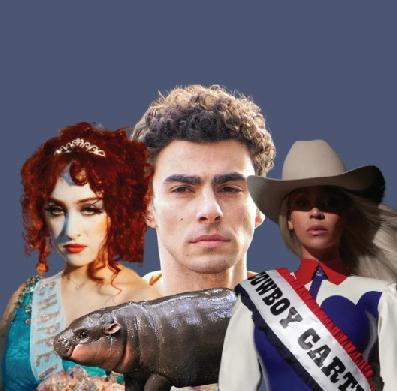

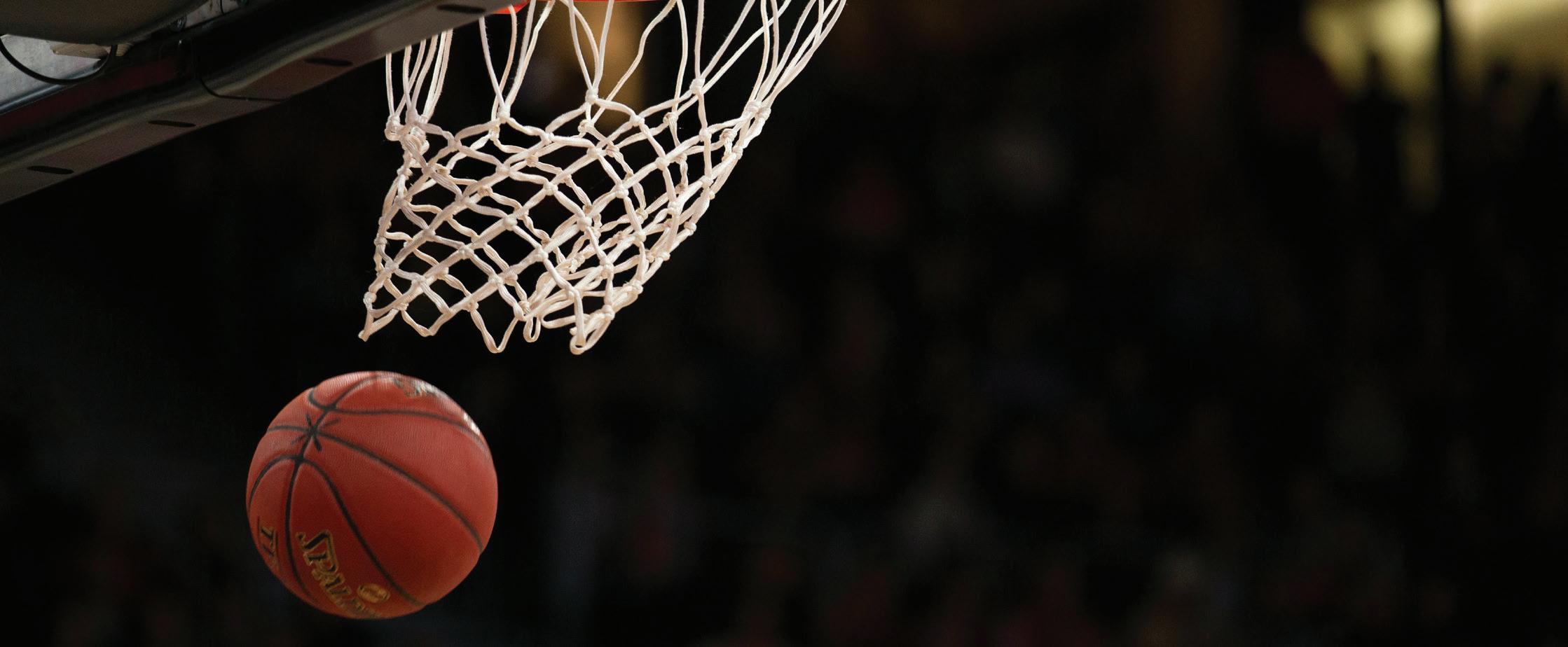
By Angelo Lien (‘28)
Imagine acing a test with a score of 97, then being told that you actually scored a 77. That 20 percent decrease is a significant drop, which the NBA is currently experiencing. If you had told someone 10 years ago that the so-called “greatest basketball league in the world” was dropping ratings by a fifth of its usual viewers, they likely would have told you to stop joking. Despite the blame being put on the NBA and its marketing, it is not the NBA’s management that is at fault. What they are missing is a superstar.
To understand the dips in viewership, we must first understand how they achieved their unparalleled success. The league began gaining attention in the 1960s, but it wasn’t until the 1980s that the NBA truly started the soar to fame. This success was due to the attraction to new talents over the years.
In the 1970s, Kareem Abdul-Jabbar became renowned for his signature skyhook. In the 1980s, two great players, Magic Johnson and Larry Bird, took the world by storm. One with swagger and
flashy passing abilities, another with a stone-cold mentality and deadly jumper, their unique personalities attracted many.
In the 1990s, Michael Jordan, also referred to by many as the greatest of all time, leaped onto the scene. With his famous tongue stick-out and dunk from the free throw line, people were captivated by his game. In the 2000s, the dynamic dominant duo of Kobe and Shaq revolutionized the game. Kobe won 5 whereas Shaq became known as one of the greatest big men to ever touch a basketball. In the 2010s, many players attracted viewers, but one stood out amongst all. Lebron King James, or the chosen one, came into the league as an 18-year-old with the pressure of the world on his shoulders. 22 years later, at 40 years old, he is still one of the premier players in the league. He has scored the most points in NBA history and is commonly referred to as the GOAT alongside Michael Jordan. However, the king is now without a crown. When asked about watching his favorite players age, Mr Joe, varsity basketball head coach says, “it takes a little bit of the shine
off their play because they’re not doing what they used to be able to do.”
“It takes a bit of the shine of their play because they’re not doing what they’ used to be able to do”
Although there is currently no solidified prince to pass the torch to, hope is on the horizon. The recent blockbuster trade (trade including a superstar) of sending European triple-double machine Luka Doncic to the Lakers to team up with Lebron James has blown up the internet. Additionally, Victor Wembenyama, a unicorn—a player with a rare or neverseen-before skill set—has started to rise to superstar status. With these two possible generational talents, the NBA no doubt has a chance to rise to its old glory.
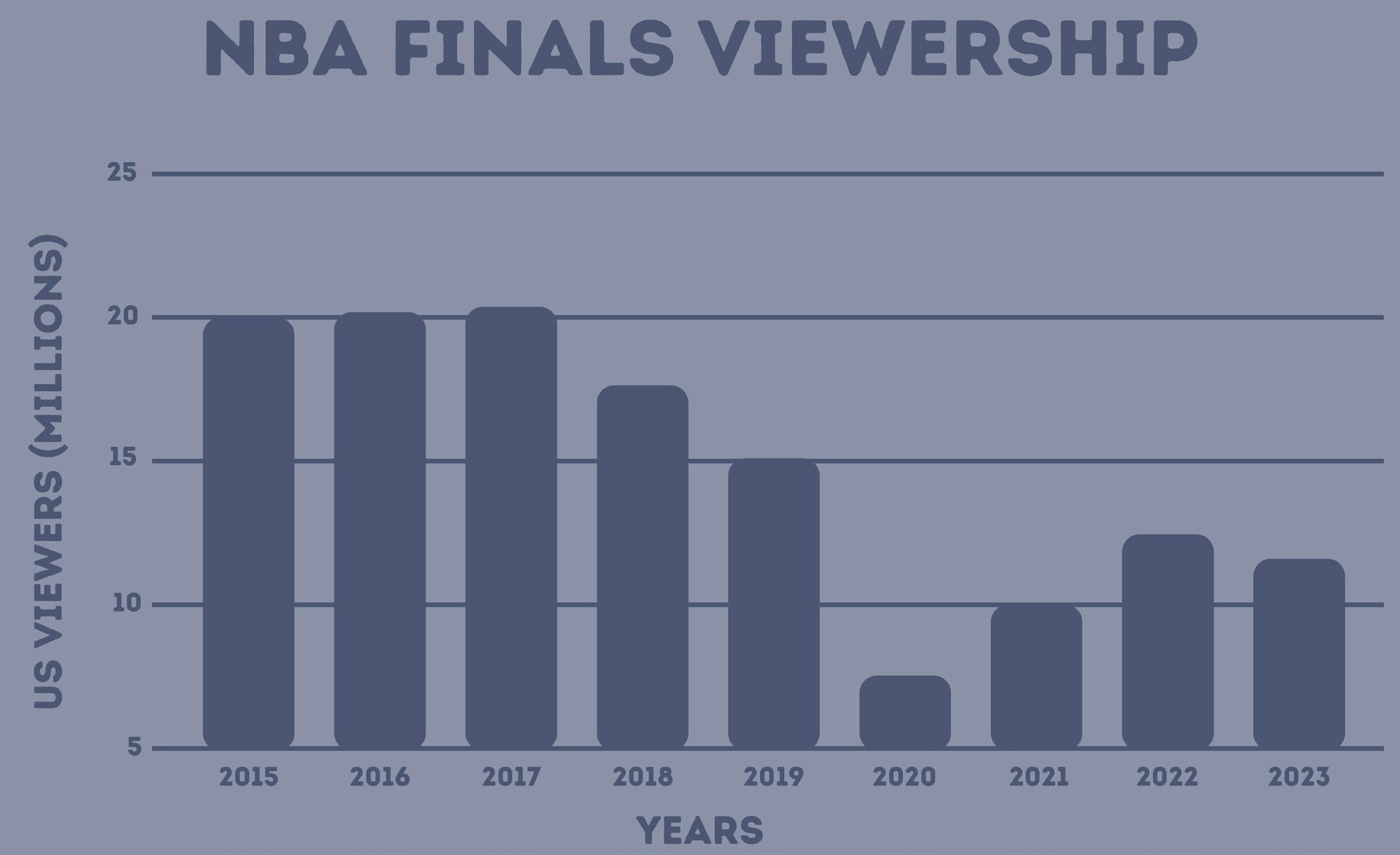


By Annabelle Hsu (‘27)
It’s June 12, 1994, and millions of Americans are gathered around their televisions watching as OJ Simpson ees the police in a captivating 90-minute car chase across California freeways. e public is enthralled by the “trial of the century,” devouring every headline and newscast broadcasting Simpson’s infamous murder case.
Yet, just across the Atlantic, an “invisible genocide” is unfolding. In Rwanda, hundreds of thousands of Tutsi civilians are being hacked to death with machetes and burned alive, herded by the hundreds into buildings set a ame.
While the courtroom drama in the US gripped the attention of millions, a far more terrifying reality was happening in Rwanda, one that received signi#cantly less media attention. is disparity is just one example of the larger, recurring pattern of Western media prioritizing maximizing their clicks and views rather than genuine education and awareness, which often allows celebrity trials to overshadow harrowing political issues. Another explanation for the media coverage imbalance is that viewers will naturally gravitate towards scandal and entertainment over serious political issues.
OJ Simpson’s trial is a concrete example of this phenomenon. e murder trial of OJ Simpson for the killings of his ex-wife, Nicole Brown Simpson, and her friend, Ron Goldman, is perhaps one of the most infamous trials in history. Because of the courtroom’s transparency and open-press access, the trial quickly became a media sensation, capturing the attention of tens of millions of Americans.
Meanwhile, in Rwanda, a planned campaign of mass murders by approximately 200,000 Hutu civilians against the minority Tutsi population from April to July 1994 was unraveling. After about 100 days, more than 800,000 Tutsi and Hutu people were killed.
A graph by political scientist Dr. Steven Livingston, published in “ e Media and the Rwanda Genocide,” shows the notable gap in media coverage between OJ’s drama and the Rwandan genocide in the nightly newscasts of ABC, CBS and NBC during the summer of 1994. It was not until late July that coverage of Rwanda began increasing.
However, by then, the massacre had already taken place, and the media generally focused on the su ering of Hutu refugees in Zaire rather than the gruesome murders in icted upon the Tutsi by the Hutu.
A more recent example of this occurring is the 2022 defamation trial between actress Amber Heard and her ex-husband, Johnny Depp, which took the internet by storm. By the end of the trial in June, the hashtag #JusticeForJohnnyDepp had amassed 20.4 billion views on TikTok and even prompted Net ix to create the “Depp v Heard” documentary.
At the same time, the Supreme Court was deliberating a decision to overturn Roe v. Wade, which would essentially overturn 50 years of precedent regarding the right to abortion in the US. In May 2022, a draft opinion by Justice Samuel Alito was released, leaking the Court’s motive to retain the Mississippi law (a 2018 law that outlawed abortions after 15 weeks), and overturn Planned Parenthood
v. Casey (a 1992 case that rea%rmed the right to abortion under Roe, while states had control of certain restrictions) and Roe v. Wade.
Although the disparity in media coverage between the overturning of Roe v. Wade and the Depp v. Heard trial was not as extreme as that between the OJ Simpson trial and the Rwandan genocide, there was still a noticeable di erence.
Data by MediaCloud demonstrates how in early May, stories concerning Roe v. Wade outnumbered those of the HeardDepp trial. However, after the news of the leaked draft subsided mid-May, attention shifted to Heard and Depp until Roe v. Wade coverage saw a substantial spike in late June, following the o%cial overturning of abortion rights.
e media shift likely had real-world consequences. Despite the di erence in the coverage not seeming to be too signi#cant, the heavy media focus on the HeardDepp trial from early May to mid-June may have taken attention away from the protests and activism against the reversal of abortion rights, especially during the period before any o%cial rulings (when the public still had time to mobilize and make a di erence).
So why do people continuously indulge in these celebrity trials instead of learning about issues that actually a ect the world?
A study by the American Psychological Association states that 56% of Americans agree that keeping up with the news causes them stress. While limiting news consumption for the sake of one’s mental well-being is understandable, there comes a point where avoiding current events becomes willful ignorance.
Another reason is the psychological appeal of celebrity trials. In “ e Press on Trial,” Lloyd Chiasson Jr. suggests that these cases contain “all the elements of good #ction: con ict, suspense, rising and falling action, deception and surprise, heroes and villains.”
Like reality television, celebrity trials serve up the perfect mix of glamour, vulnerability and scandal, making them di%cult to ignore.
Ultimately, I believe that the key to combating this dynamic lies with viewers and the news outlets.
To break the vicious cycle of marketdriven media companies catering to the demands of their audiences and ending up with tabloid journalism, we must consciously uncouple our news and entertainment channels. is way our news can remain focused on matters that truly impact us, while celebrity gossip can remain in the realm of entertainment.
On the other hand, the news companies themselves have to keep their journalistic integrity in-check. Regardless of the preferences of their audience, these companies have a moral duty to report on any crises or situations of importance, even if they aren’t the most sought after topics.
Only after both the consumers and suppliers of media actively decide to get rid of this unproductive pattern, will we begin to see change.
But when is that change going to come? I guess the shiny new lawsuit between actors Justin Baldoni and Blake Lively, that is already making its mark on the list of notorious celebrity lawsuits, is the perfect chance for us to get a glimpse of how doomed media actually is.

By Sian Park (‘27)
“I was being a big back!”
Megan C. (‘27)
“I had dinner with my extended family.”
Anthony K. (‘27)
“I danced at home because dance studios are closed!”
Wendy C. (‘27)
“I was sleeping 14 hours.”
Tingting C. (‘27)
“I learned Mahjong.”
Kaela A. (‘27)
“I was at Japan for VEX!”
Natasha L. (‘26)
“I ate a lot of good food and slept.”
Charlotte W. (‘28)
“I skied in Japan with my cousins in Nagano for 5 days, and saw snow for the first time.”
Chelsea C. (‘28)
“I went to my grandparent’s house and ate a ton of food. I probably gained like 20 pounds but it was worth it.”
Alice V. (‘28)
“Over Chinese New Year break, I visited my family in Malaysia, watched my brother gamble all his hongbao money away into oblivion, and had many family gatherings and dinners.”
Sarah K. (‘28)

Despite being known as the “woke” generation, bigotry lives on in popular Gen-Z slang.
By Sofa Valadao (‘26) & Sian Park (‘27)
In today’s world, Generation Z – those born between the years 1997 and 2010 –have been relentlessly barraged with labels: if it’s not Gen X-ers calling us immature and anxiety-prone, then it’s Baby Boomer politicians accusing us of taking over the world with TikTok. But one nickname in particular has managed to supersede them all: woke.
Although the term ‘woke’ has come to be associated with overzealous political correctness and cultural elitism in recent years, it ultimately still connotes notions of social consciousness and awareness of injustice. Gen Z has constructed a distinct reputation for ourselves, one of aggressive inclusivity and acceptance. It’s also always been the conventional wisdom that each generation grows more progressive and socially enlightened than the previous one, pushing for greater justice in society than their parents did. But…is that really true? Or does bigotry – a phenomenon rooted in disgust and divisiveness – simply rebrand itself as time goes on?
Although there’s certainly a small portion of Gen Z that’s wrapped up in the hyperconservative online realm of trad wives and misogynistic podcasters, bigotry has manifested itself in Gen Z in more insidious ways—and on a much larger scale. An alarming number of slang terms we use on a daily basis have discreetly prejudiced or outright discriminatory meanings. Browse through one Instagram or TikTok comments section, and you’ll find them all.
Te term ‘zesty’ is used to describe a man
who is homosexual or who displays ‘feminine characteristics,’ often employed in a ridiculing and insulting manner. ‘Bop’ is a denigrating term used to describe a woman who has dated or had sex with many men. Te term ‘acoustic’ is supposedly a ‘clean’ rendition of the word ‘autistic’—it’s used to belittle and mock someone who is unintelligent, behaves abnormally or is disabled. ‘Pick me girl’ is a phrase that was originally meant to describe a woman who revolves her identity around male validation, but is now used whenever someone finds themselves remotely irritated with a woman—if she’s short and mentions it often, she’s a ‘pick me’; if she’s tall and mentions it often, she’s a ‘pick me’; if she spends a lot of time with her boyfriend, she’s a ‘pick me’; if she has male friends, she’s a ‘pick me’; if she talks about her abilities and accomplishments, she’s a ‘pick me’.
It’s easy for us Gen-Zers to disregard and overlook the true connotations of these terms, simply because of how normalized and widely used they’ve become. It’s also difficult for older generations to hold us accountable for employing them; these terms are really only circulated in spaces dominated by our age group – like TikTok and Instagram Reels – and the words themselves are quite arbitrary, strange and difficult to decipher for those who aren’t already familiar with them.
Nonetheless, when we truly examine and unpack these words, it doesn’t take a genius to see the parallels between Gen Z slang and derogatory terms that were once casually used by older generations to ridicule certain groups, but are now deemed completely dehumanizing and unacceptable. ‘Bop’ is
simply a synonym for ‘slut’, ‘acoustic’ a synonym for ‘retard’, ‘zesty’ a synonym for the f-slur. Gen Z isn’t any less prejudiced than Millenials and Gen-Xers were when they were teenagers; the language employed by those older generations was policed, but the discriminatory ideas that inspired them weren’t dismantled at all.
Any word that is laced with bigotry is an awful one, no matter how normal and harmless it may seem. Not only do these terms ridicule, offend and dehumanize the people targeted by them (like women, members of the LGBTQ+ community and disabled people), but your usage of them can have dire effects on your own life. Twenty years from now, words like ‘bop’ and ‘acoustic’ could be flagged and abandoned for their discriminatory meanings, just like the words ‘slut’ and ‘retard’ were. If you commented or posted a video of yourself employing one of these terms, your ability to be admitted to schools, programs and jobs may very well be nonexistent.
Now, we’re not necessarily suggesting that Gen Z eradicate every element of fun and controversy from our colorful diaspora of slang…but there’s a difference between amusement and blatant discrimination. If you ever find yourself using a popularized slang term to denigrate, insult or embarrass someone because of something they can’t control (like their gender, sexuality, race or disability status), check yourself. Tere are countless qualities and characteristics of older generations that us Gen Z-ers ought to emulate more…but bigotry certainly isn’t one of them.


When researching for this article, I felt the urge to open Instagram on my phone. In fact, the very idea to write about social media addiction came from scrolling through Instagram reels. e existence of this article proves how deeply embedded social media is in our lives.
As we navigate our teenage years, we are constantly reminded by peers and adults about the dangers of social media: cyberbullying, anxiety, low self-esteem, depression and, most notably, social media addiction.
With the rapid development and spread of social media in the past decade, the idea that a social, content-making app is inherently bad is not a common belief. However, despite the global connection it facilitates, and its role as a platform for sharing knowledge, the long-term e ects of social media can be just as harmful as substance abuse.
While everyone acknowledges the risks, signs and e ects of social media addiction, few take action to address it. And social media companies have long utilized psychological tactics to keep users immersed in their platforms—so who truly bears the responsibility for addiction? Should users be held accountable if they are being subtly urged to excessively consume?
Social media platforms are designed to trigger rushes of dopamine to the brain,
to make users return again and again. Once the brain receives these rushes, social media becomes increasingly di cult to resist. Adolescents are even more vulnerable as brain development remains ongoing, making them more susceptible to addiction through impulsiveness and other factors. e need for social connection, as humans are inherently social beings, is another reason—not just for adolescents— to reach for social media. With instant, a ordable access to social media platforms, the urge to chase never-ending dopamine is even more enticing than ever.
Triggers such as noti cations activate the brain’s reward center, resulting in a rush similar to that of gambling or using drugs. is rush induces repetitive behavior, which creates a trigger-action-reward cycle that hooks people and continues even as it turns self-destructive. After an extended period, habits are formed and triggers are no longer needed to entice consumers.
Social media companies purposefully impose addiction on their users for nancial gain, not just through noti cations and alerts, but also through the very structure of their platform. e in nite scroll was created so that users can endlessly swipe without clicking; without the necessary stopping cues, people continue scrolling incessantly. Noti cations are colored red, which subconsciously signals their “importance.” Algorithms for a user’s
“For You” page are personalized, catering to an individual’s interests so they remain on the app longer. Gami cation elements produce a sense of accomplishment, such as the “Snapstreak” on Snapchat, which counts the total consecutive days users send each other pictures or videos. Likes, comments, shares and views of posts make people seek constant social validation. All these tactics are used to psychologically manipulate consumers to stay on social media platforms for far longer than they realize.
As a result, addiction to devices and social media is plaguing the young, and oftentimes older generations, creating an overload of mental, physical and emotional harm, including depression, substance abuse, suicide and sleep deprivation. Addiction can be classi ed as the dependence on a behavior, where individuals are unable to stop, even when it interferes with other aspects of their life.
ose with trouble controlling time spent on social media can seek the support of peers or trusted adults to help them regulate their time and remind them to stop.
Goals can be set to limit time on social media and nd alternative non-digital hobbies or activities to do. Noti cations can also be turned o to reduce the urge to check apps and instead plan meetups with friends and family.
Apart from users controlling their habits, platform developers should impose comprehensive design improvements, such as stricter time limits, age limits and prompts to encourage taking breaks. Gami cation of healthy use features or apps that reward users for spending time o ine could be implemented as well. Online community support can provide and share resources on how to manage social media habits.However, these suggestions do not address the core issue voiced by researchers: that social media encourages people to stay hooked to their screens.
ough lack of self-control and many other life struggles that adolescents endure play a factor in the rising number of social media addiction cases, they should not be held solely accountable.
Delegating the responsibility of managing addiction to app stores, parents or the youth fail to address the harms inherent in social media platforms—much like casino slot machines that keep players hooked. ese platforms have become digital casinos, drawing users into cycles of compulsive use.
Rather, the responsibility of managing addiction lies with the platform developers and providers of these technologies as well, to structurally correct harmful design features and functions prevalent in many media platforms today.
By Colin Kuo (‘28)
e movie business has been in a slump, and exceptional lms are getting harder to nd. 2024 was full of highly anticipated movies, but many of them didn’t meet expectations. Movies such as “Joker: Folie à Deux,” “Venom: e Last Dance” and “Gladiator 2” all fell short of expectations. Another one was “Moana 2,” a much-anticipated follow-up to the 2016 original.
Visually, the lm was stunning. e ocean glows with shades of blue; waves roll gently under the bright sun. Vibrant green islands rise in the distance, each detail of the landscape rich and full of life. Moana—– once again voiced by Aui’i Cravalho—– continues to be a strong and determined protagonist, while Dwayne Johnson’s return as the witty demi-god Maui adds fun and joy to the lm through his charismatic personality. One of the standout moments is his new song and catchphrase “Can I get a Chee-Hoo”?
One aspect that contributes to the problem of “Moana 2” is its narrative, as it feels like a recycled version of the rst one. In the rst lm, Moana sets out on a journey to save her people with help from Maui. In “Moana 2,” the same thing happens once again. Her personal growth is still a major focus in the movie, but this time without the same emotional impact, as we’ve seen her overcome

similar challenges in the rst lm, making her resilience feel more predictable. Additionally, the pacing is uneven; the introduction of new characters like Loto, Kele, and Moni is rushed, leaving little time for the audience to fully connect with them. Meanwhile, several songs with extended durations such as “Beyond” and “Can I get a Chee Hoo?” drag on longer than necessary, making those moments in the movie feel slower.
Another element that falls short of expectations is the soundtrack. Even though the songs are still good, none of them stand out in the same way as “You’re Welcome” and “How Far I’ll Go” from the rst movie. e new songs lack that memorable quality, and aren’t catchy whatsoever.
Despite its problems, “Moana 2” is entertaining, especially for younger viewers and those who enjoyed the rst lm. It’s full of adventure, emotions and a meaningful message of self-discovery. However, it might not live up to the expectations of those hoping for a truly innovative sequel. Overall, I’d give “Moana 2” a 3 out of 5 stars. It’s a visually stunning and entertaining movie, but its lack of innovation and uneven pacing hold it back from being an outstanding movie.

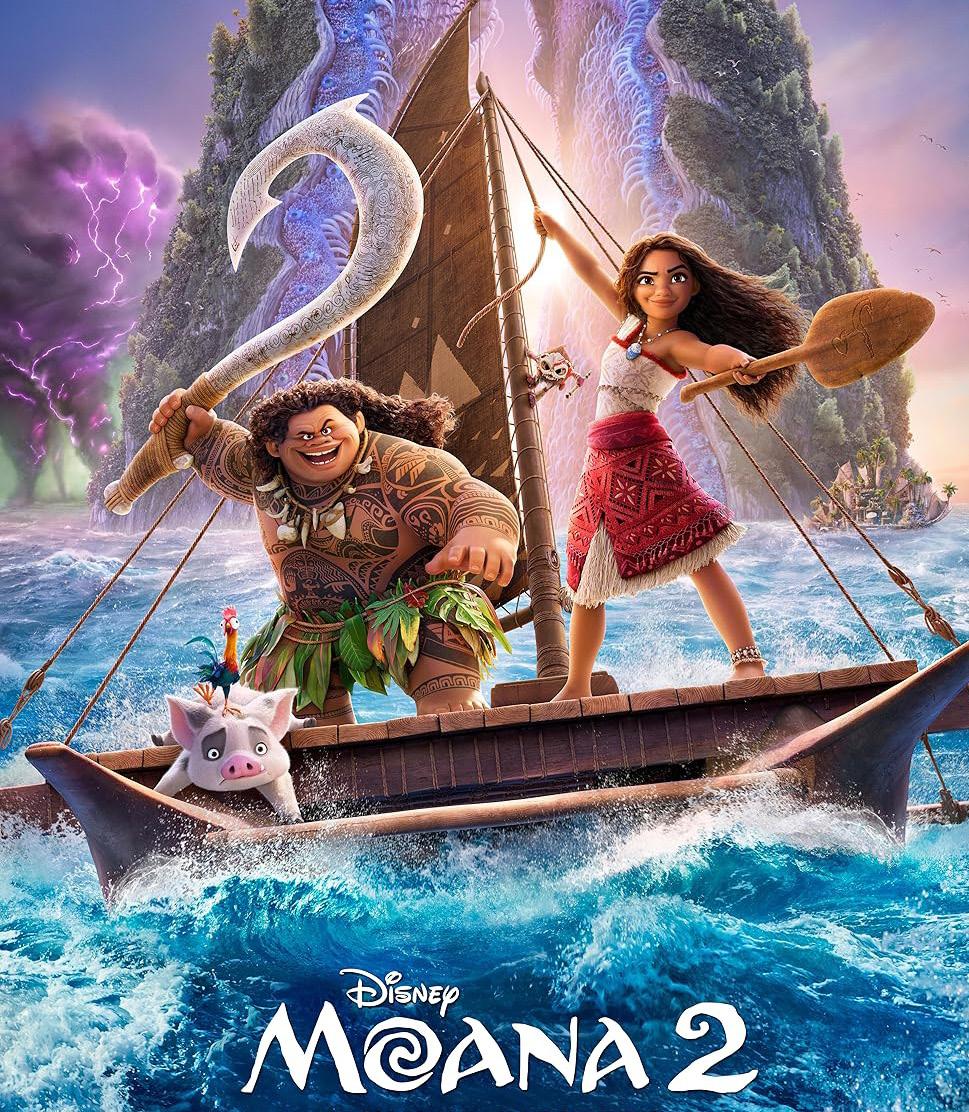

By Hannah Wang (‘27)
“Mufasa: e Lion King,” takes the audience back into the mythical Pride Lands. Directed by Academy Awardwinning director and lmmaker Barry Jenkins, this prequel to the Disney movie “ e Lion King” (1994) takes viewers on an action-packed journey to explore Mufasa’s journey, from an orphaned cub to a heroic leader.
e lm is framed through Ra ki’s storytelling, as he recounts Mufasa’s journey. Ra ki, the wise mandrill and royal advisor to the Pride Land is the narrator, passing down Mufasa’s legacy to the next generation. After being swept away from a ood, orphaned cub Mufasa meets a lion named Taka, the heir to a royal bloodline. e two become friends, but as the story progresses, the di erences in their backgrounds and ambitions create a barrier between them. is dynamic adds a new layer to the classic “Lion King” story. Visually, “Mufasa” is breathtaking. Using the same hyper-realistic GCI as the 2019 “Lion King,” the lm brings the African savanna to life with incredible detail. Every frame is a visual masterpiece, from sweeping landscapes to detailed character expressions. e animations have improved since the prior adaptations, with more re ned, smoother, and natural animations, making the experience more immersive.
Music has always been a cornerstone of the “Lion King” franchise, and “Mufasa” ful lls that tradition. Composed by the Grammy Award-winning songwriter LinManuel Miranda, “Mufasa” introduces a fresh, yet nostalgic music style that
complements the story well. e soundtrack blends African rhythms with heartfelt melodies that add to the story’s emotional impact. Lin-Manuel Miranda’s signature storytelling is woven into songs, showcasing that each song serves a purpose beyond just entertainment, but it also drives character development and deepens emotions.
Beyond the visuals and music, what makes “Mufasa: e Lion King” compelling is its emotional core. e lm isn’t just about Mufasa’s rise to power and the relationships that de ne him. His friendship with Taka, his relationship with his parents, and the mentorship he receives, all help shape his journey.
Overall, “Mufasa: e Lion King” deserves four stars, for its breathtaking visuals, emotional storytelling and powerful soundtrack.
If you loved the iconic 1994 “Lion King” movie, watching “Mufasa” will de nitely be worth your while.



By Amber H. (‘27)
After a long, COVID-delayed wait, Broadway favorite “Wicked” was brought to theatres on Nov. 22, 2024. But through the glitter and colors, director Jon M. Chu had big shoes to ll to live up to “Wicked’s” impressive legacy. Nearly three hours long, I had high expectations as I stepped into the theatre.
Starring Tony Award-winning actress Cynthia Erivo as Elphaba—the misunderstood green witch—and pop star Ariana Grande as the bubbly, popular Glinda, the movie sets o with Elphaba’s trip to the famed Shiz University to accompany her sister. Although she intended to lie low, Elphaba’s hidden powers are unexpectedly revealed to the entire school, and she is convinced to attend Shiz to develop her powers. Paired with Glinda—her polar opposite—as her roommate, Elphaba struggles to t in at Shiz. Elphaba and Glinda’s di erences couldn’t be more clear. One green and one pink, one irtatious and outgoing while the other serious and shy. Despite having their own motives, Elphaba and Glinda form an unexpected friendship, navigating school and eventually traveling down to the Emerald City to meet the Wizard of Oz together.
Visually, the lm is awless. With a vibrant and thoughtful color palette, it emphasizes the contrast between Elphaba and Glinda through the use of pink and green, especially highlighted in their split dorm room where their key colors are physically divided with a line. e special e ects, displayed with Elphaba’s powers,
are seamlessly woven through—subtle, but magical. e soundtrack plays o of the original Broadway musical, with catchy songs such as “Defying Gravity” and “Popular.”
However, considering it’s nearly three hours long, you’d expect there to be more action. e lm’s pacing is largely focused on building Elphaba and Glinda’s relationship, with the actual con ict only being introduced in the nal thirty minutes when they meet the Wizard of Oz. Because the story rushes to its peak, the uneven pacing feels frustrating, rather than exciting.
Although this did create amazing character development and chemistry between the characters, I expected a lot more movie action after sluggishly waiting through almost three hours of singing.
Perhaps the plot could’ve been reduced. ere seemed to be no point in having a love interest for Glinda. Elphaba’s sister could have made fewer appearances. It also seemed pointless to split the movie into two parts. By splitting it up, we completely lose the plot in the rst movie and the character development in the second.
Overall, “Wicked” only deserves three stars. Although the visuals and music were impressive, I left the theatre feeling as if I’d wasted three hours of my life. Perhaps my expectations were too high. With a second part of the movie set to be released later this year, I can only hope that this one will be better, because “Wicked” was wickedly disappointing.



By Erin W. (‘25)
James Mangold’s “A Complete Unknown” is a vibrant, immersive dive into the early years of musical legend Bob Dylan’s rise to fame, chronicling his transformation from a scrappy folk singer in Greenwich Village to a generational icon. With Timothée Chalamet in the lead role, the lm captures Dylan’s enigmatic presence, rebellious spirit and ever-evolving artistry with a sense of authenticity that’s rare in musical biopics.
Timothée Chalamet delivers a performance that goes beyond impersonation—he embodies Dylan’s restless soul. His voice, mannerisms and mysterious charm feel natural rather than forced, making his portrayal both convincing and engaging.
e lm’s decision to have Chalamet sing live on set adds a raw, unpolished texture that mirrors the grit of Dylan’s early sound. Whether he’s strumming an acoustic guitar in a smoky Village club or de antly plugging in at the Newport Folk Festival, Chalamet’s Dylan is mesmerizing.
Mangold’s direction brings 1960s Greenwich Village to life with remarkable detail. e cinematography bathes the city in warm, nostalgic hues, capturing the creative chaos of the folk scene. e lm’s supporting cast—Monica Barbaro as Joan Baez, Elle Fanning as a ctional love interest and Edward Norton as Pete Seeger—add depth to Dylan’s story, showing how his relationships shaped and complicated his rise to fame.
Unlike traditional musical biopics, “A
Complete Unknown” avoids heavy-handed exposition or a by-the-numbers retelling of Dylan’s greatest hits. Instead, it moves like a Dylan song—elliptical, poetic and sometimes incomprehensible. e lm lingers on moments of inspiration and de ance rather than major life events, which may frustrate viewers looking for a more structured narrative. Yet, for those willing to embrace its freewheeling style, it feels truer to Dylan’s essence than a conventional biopic ever could.
At its core, “A Complete Unknown” is a lm about artistic reinvention. It captures the tension between staying true to oneself and evolving with the times—a struggle Dylan faced when he traded acoustic folk for electric rock. e climactic Newport Folk Festival scene, where Dylan electri es (and alienates) his folk audience, is staged with electrifying energy, re ecting the lm’s central theme: great artists never stand still.
“A Complete Unknown” isn’t a traditional biopic by any means—it’s an atmospheric, evocative portrait of an artist who de ed de nition. While it may not answer every question about Dylan, it captures his spirit, making it a must-watch for fans and a fascinating introduction for newcomers. With a career-de ning performance from Chalamet and Mangold’s steady direction, the lm stands as a tting tribute to one of music’s greatest shape-shifters.

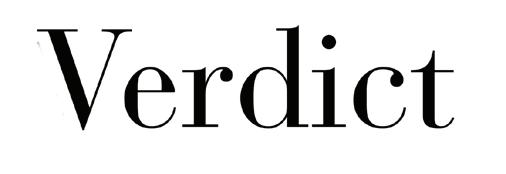
By Bryce Yao (‘28)
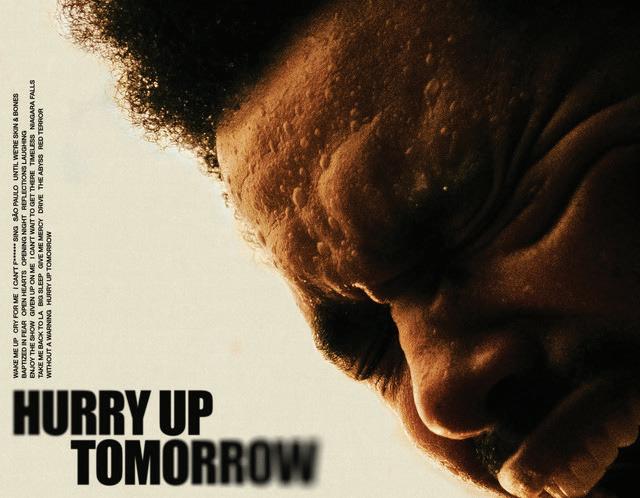
Released on Jan. 31, 2025, Hurry Up Tomorrow was released as the final installment in a trilogy of albums by e Weeknd, alongside After Hours (2020) and Dawn FM (2022), marking the end of his illustrious career.
e album contains 22 songs and 84 minutes of greatness. With features from music stars Anitta, Future, Playboi Carti, Travis Scott and Lana Del Rey, e Weeknd and producer Mike Dean gave fans multiple hit songs like “Cry For Me,” “Open Hearts” and “Wake Me Up.”
Being e Weeknd’s final album, Hurry Up Tomorrow is filled with references to old hit songs by the artist.
“I Can’t Wait To Get ere” references the platinum single “I Was Never ere;” “Cry For Me” references the triple platinum single “Save Your Tears;” “Given Up On Me” references the double platinum single “Pray For Me.”
With the artist telling fans in the past,

Released on Jan. 24, 2025, CAN’T RUSH GREATNESS is the debut studio album of British rap superstar Central Cee, establishing a real start to his already amazing career.
Released through Columbia Records, the album is a British hip-hop and UK drill album containing 17 songs, and spanning a short 48 minutes and 51 seconds. e album, which debuted at number nine on the Billboard 200 charts and number one on the UK Albums chart, marks the historical threshold of being the first British rap album to reach the top 10 on the Billboard Hot 200 Albums chart.
With a mix of catchy lyricism, highquality production and features from very prominent rappers like Dave, Lil Durk, Lil Baby and 21 Savage, Central Cee’s CAN’T
“I still want to kill the Weeknd,” the songs that are essentially a part two to some of his most popular songs give fans a feeling of fulfillment as his career ends.
In terms of the music on the album, the instrument most prevalent throughout the entire album is the bass, setting the tone for the album from the beginning with “Wake Me Up (feat. Justice).”
Another aspect that stands out throughout most of the songs on the album is the chorus.
In most of the songs, e Weeknd’s voice raises a few octaves as the song reaches the chorus, giving o ff an angelic vibe.
With top-of-the-industry production and a superstar lead, the album checks every box for a major hit and is just great music to listen to.
I would rate this album a 9.4/10, with must-listens like “Niagara Falls,” “Timeless” and “Wake Me Up Tomorrow.”
RUSH GREATNESS contains many hit songs, like “BAND4BAND (feat. Lil Baby)”, “Gen Z Luv” and “GBP”, with only the last being a new release this year. ough Central Cee’s monotone delivery comes o ff as repetitive as time, CAN’T RUSH GREATNESS displays the lyricism and straightforward tone that Central Cee is famous for.
Being his own album, it is only fitting that Central Cee has the best verse on every song on the album, truly establishing his prowess and skill even in the presence of other stars.
His ability to utilize the amazing instrumentals to complement his work gives me no chance to rate the album anything lower than an eight, so I’d rate it an 8.4/10.
